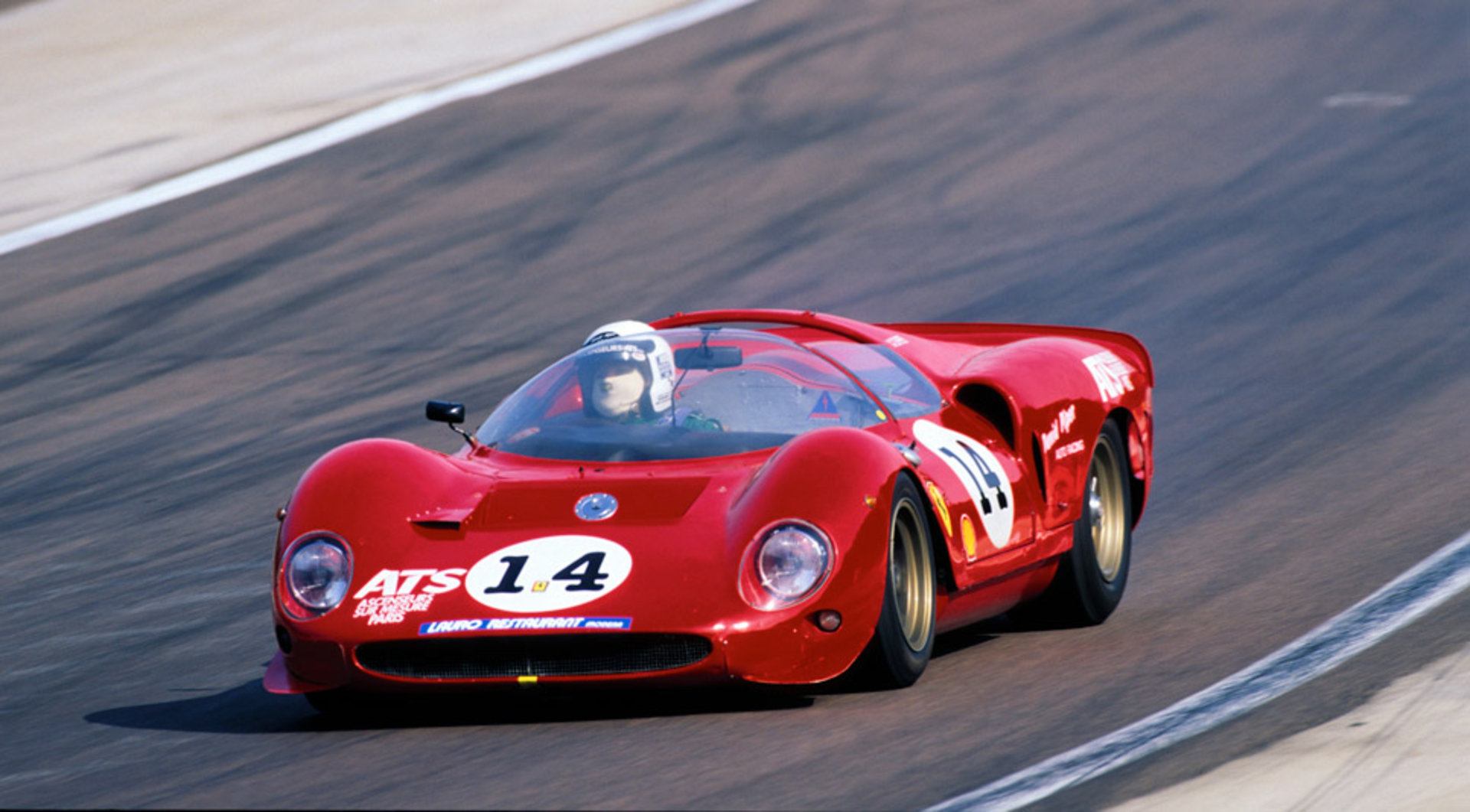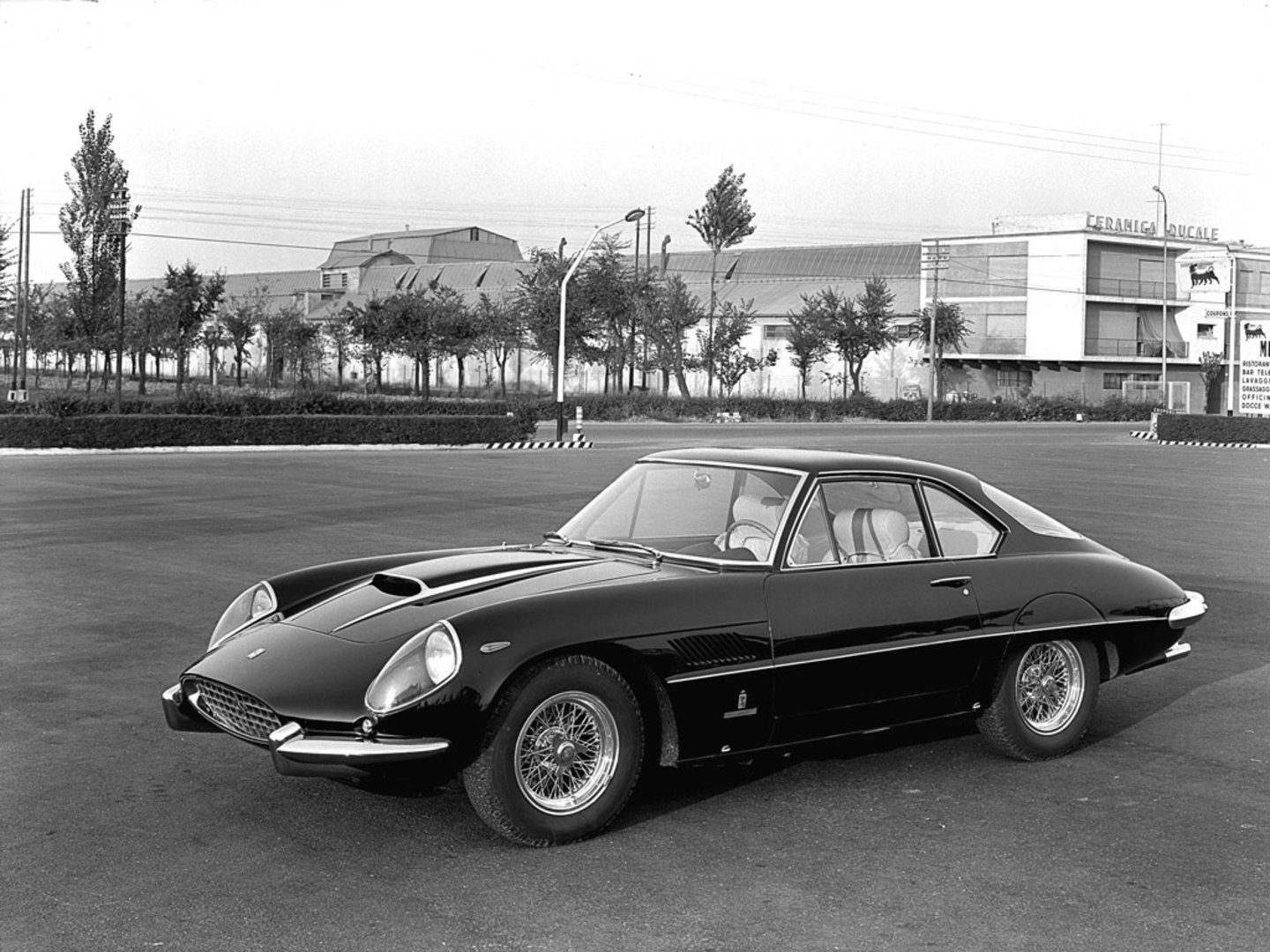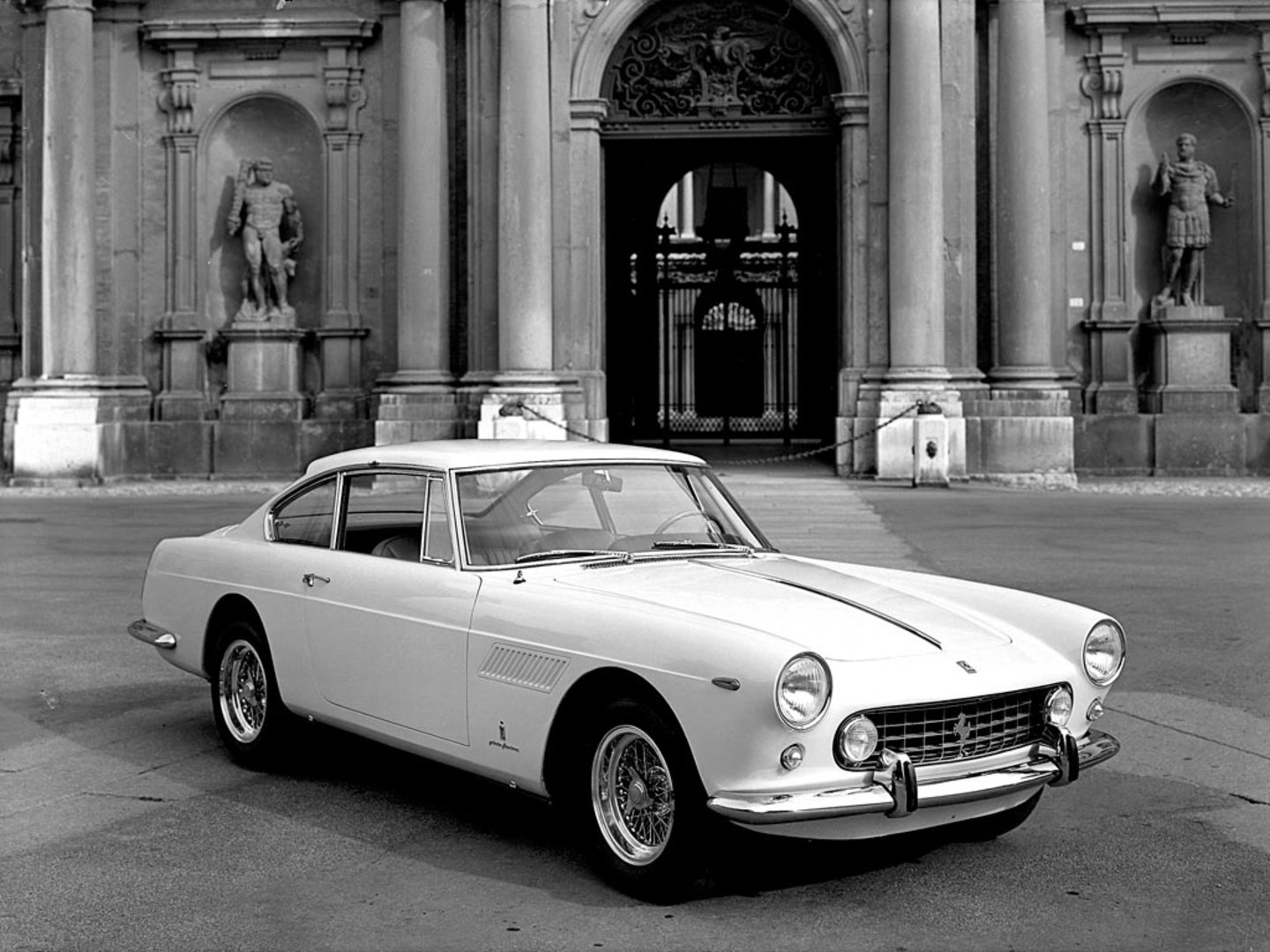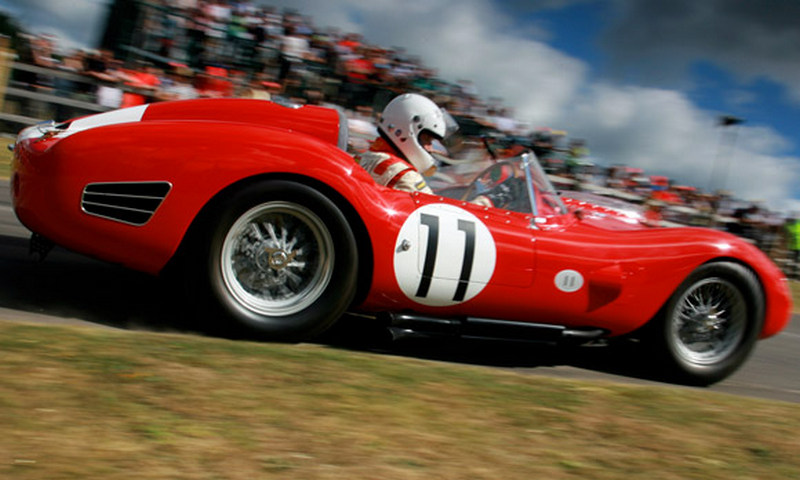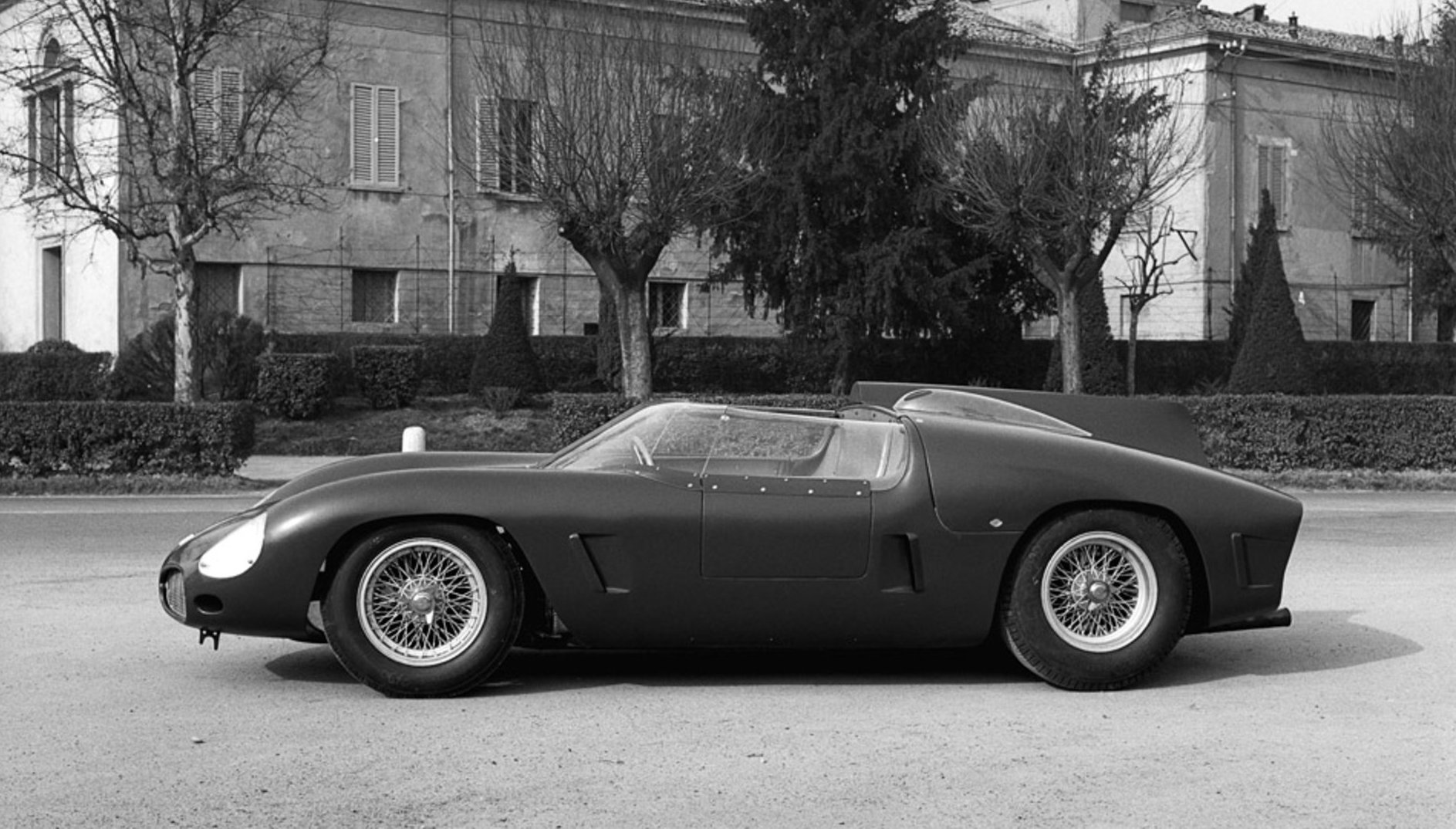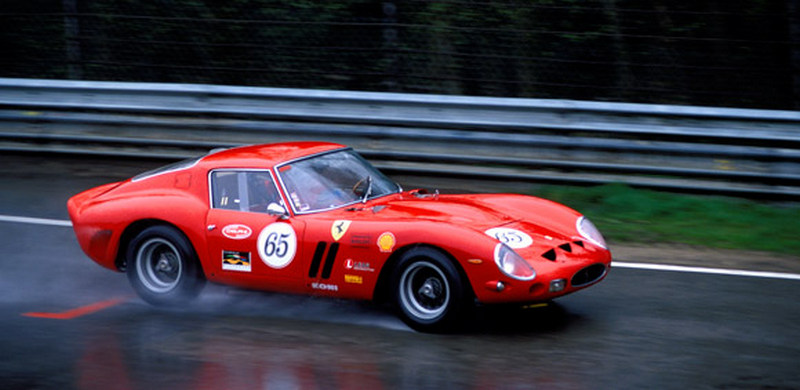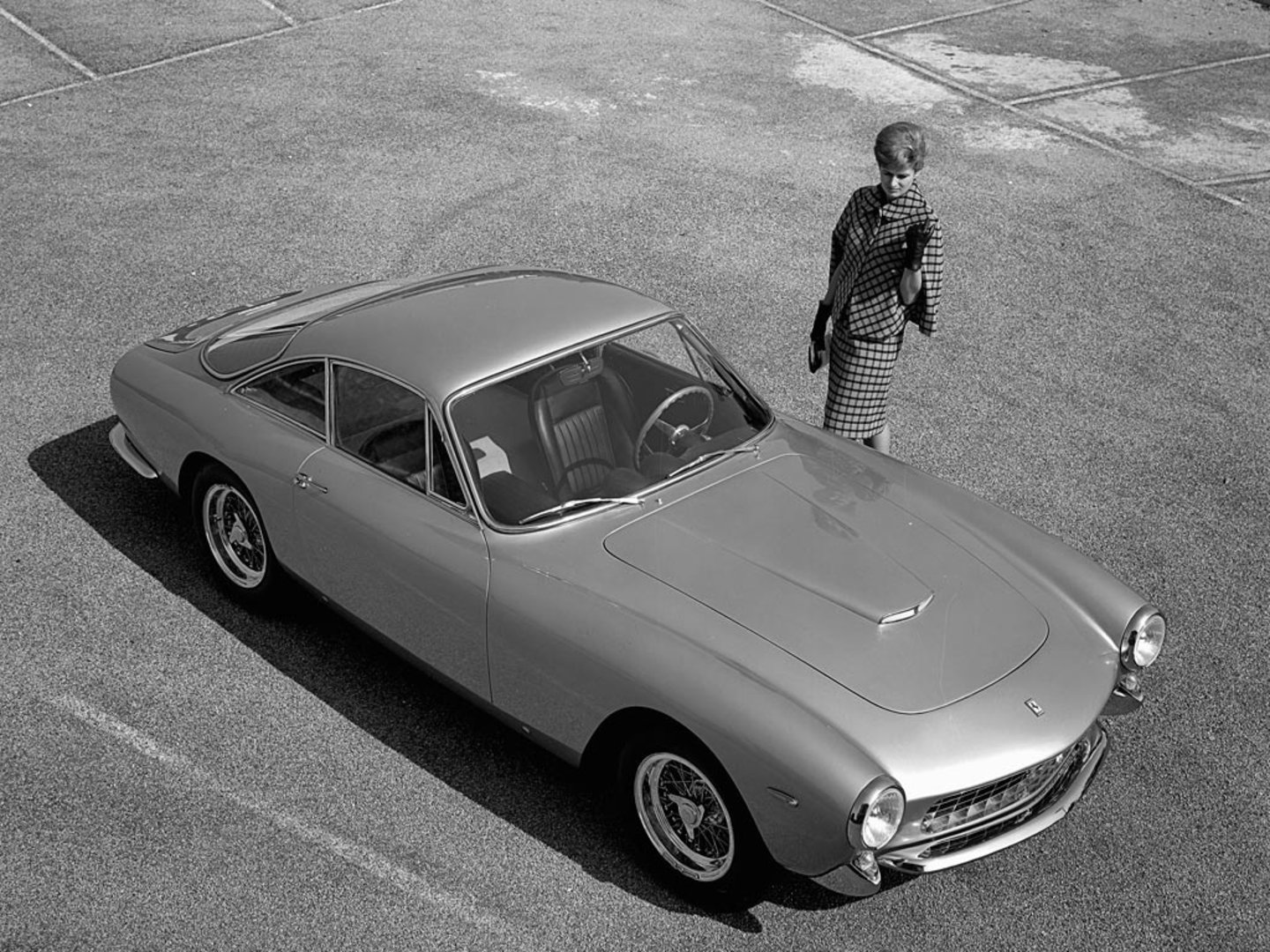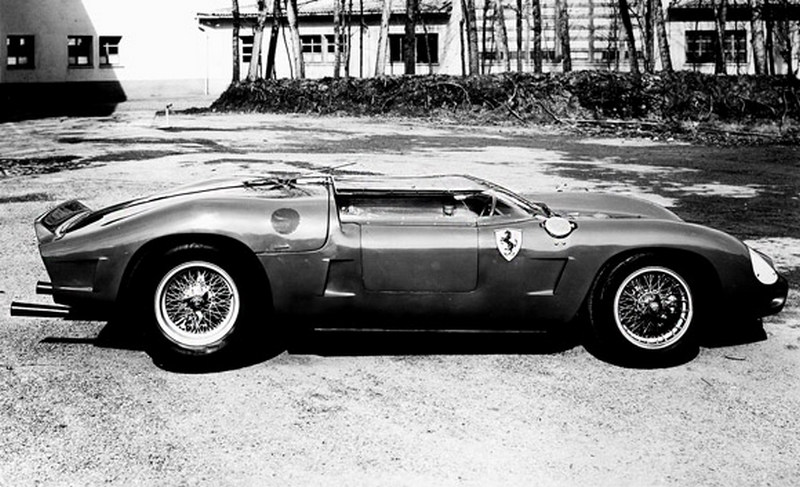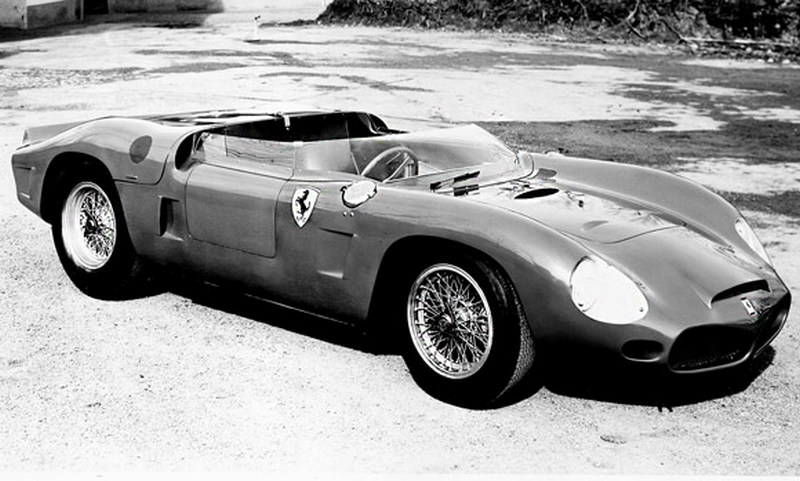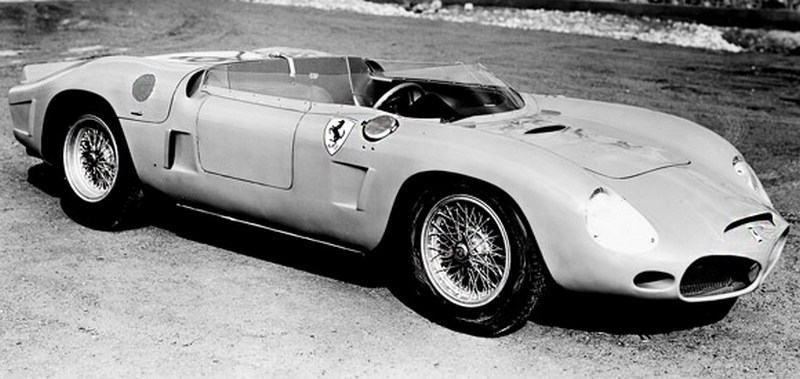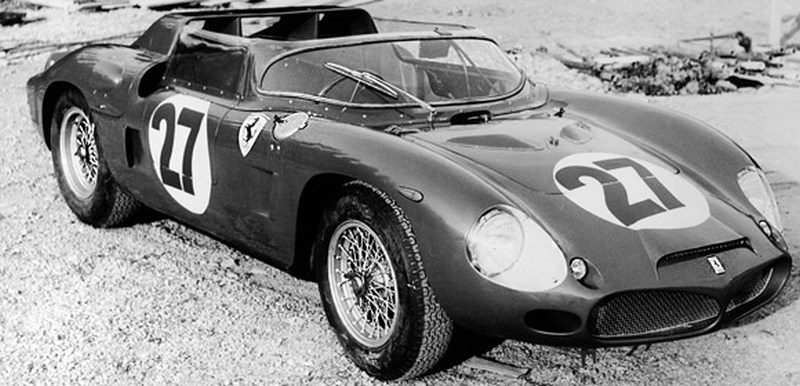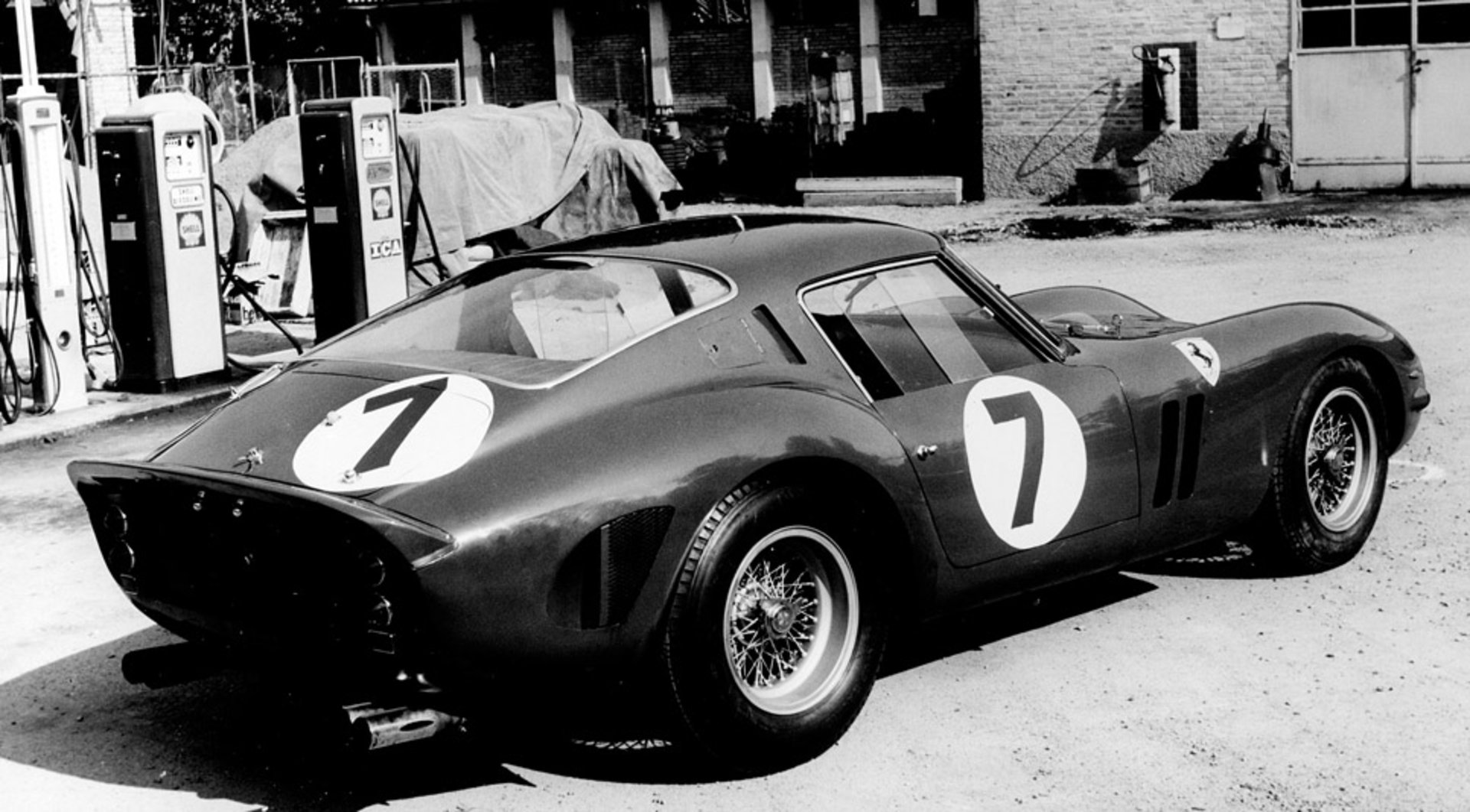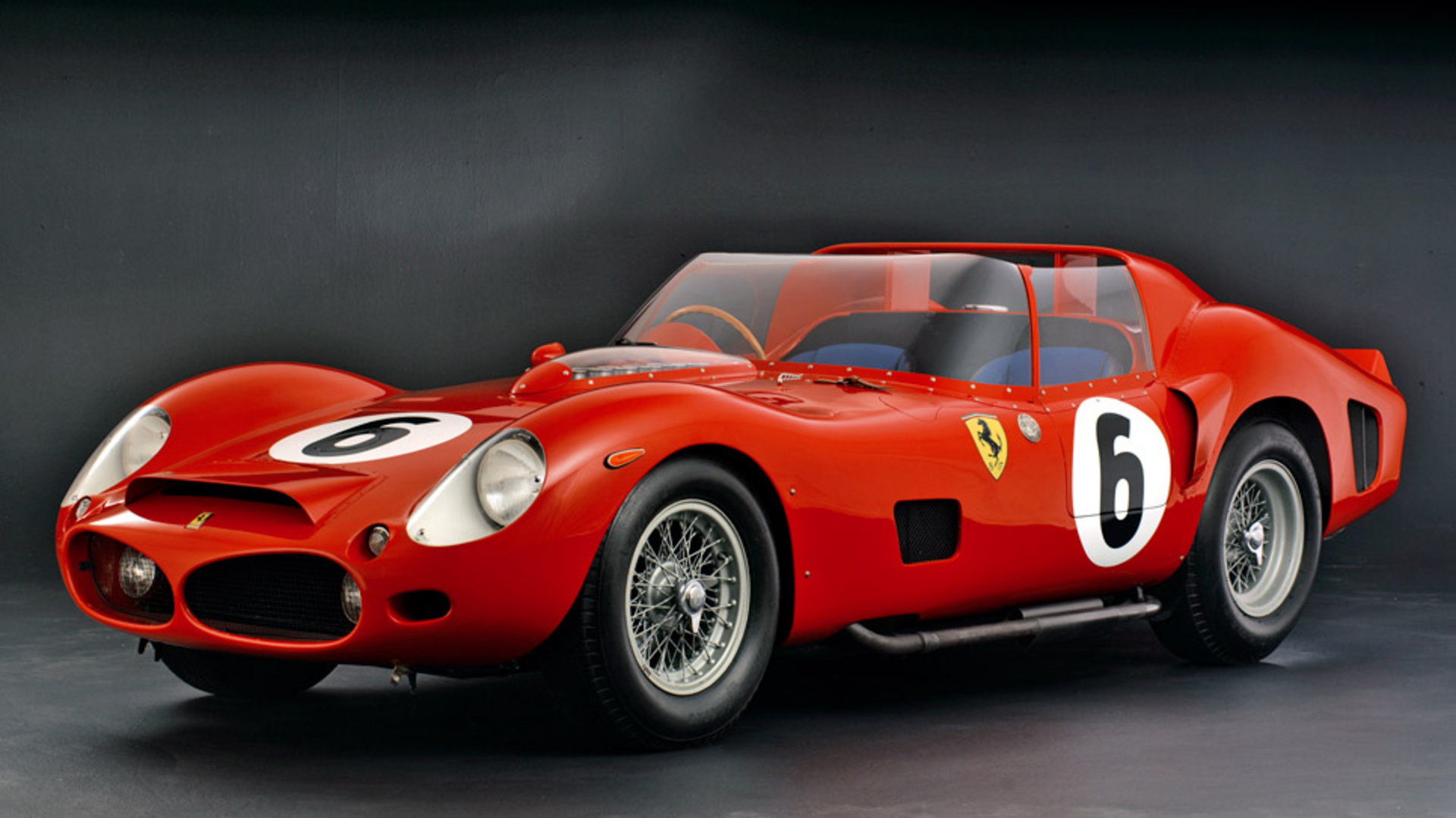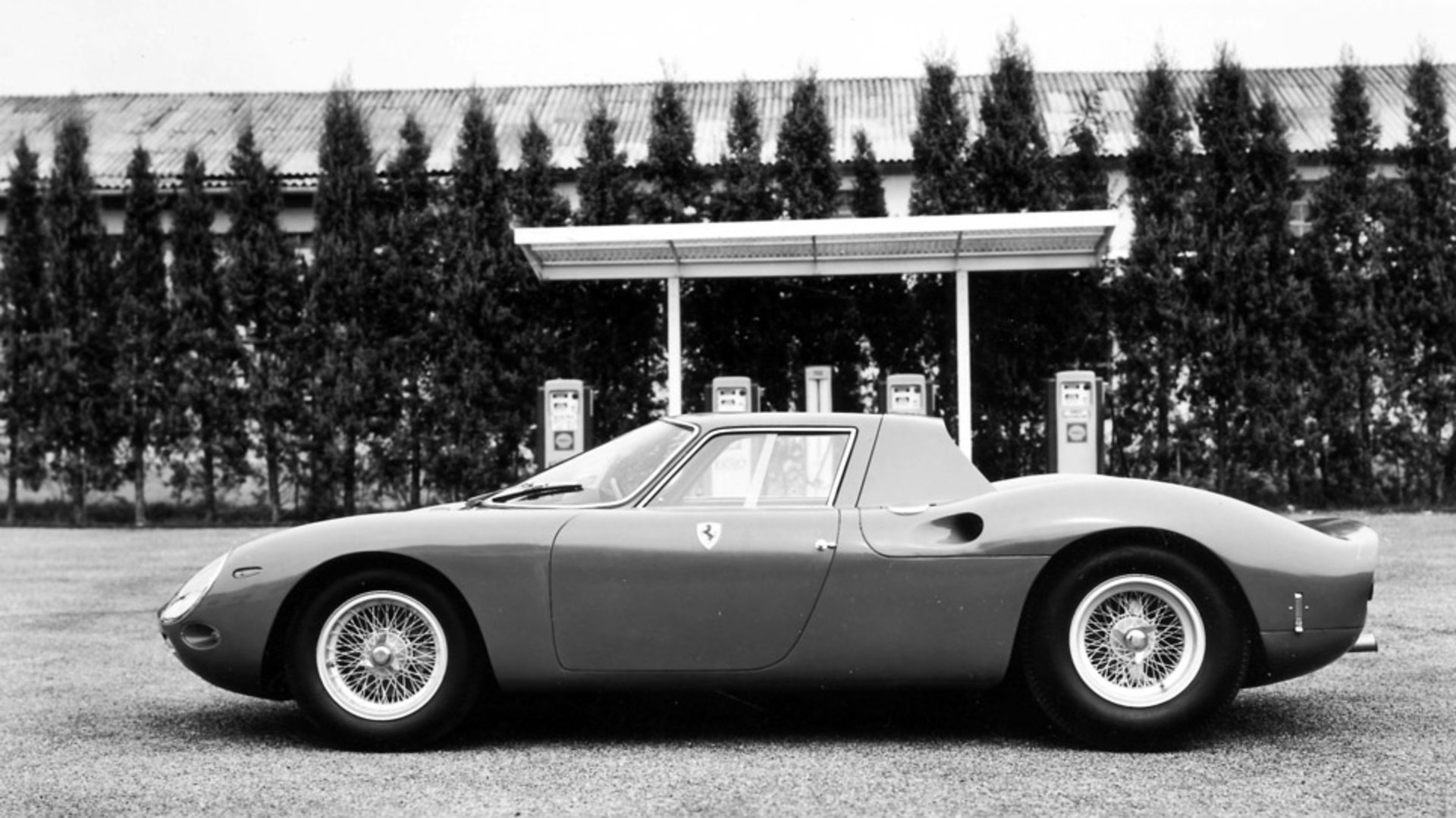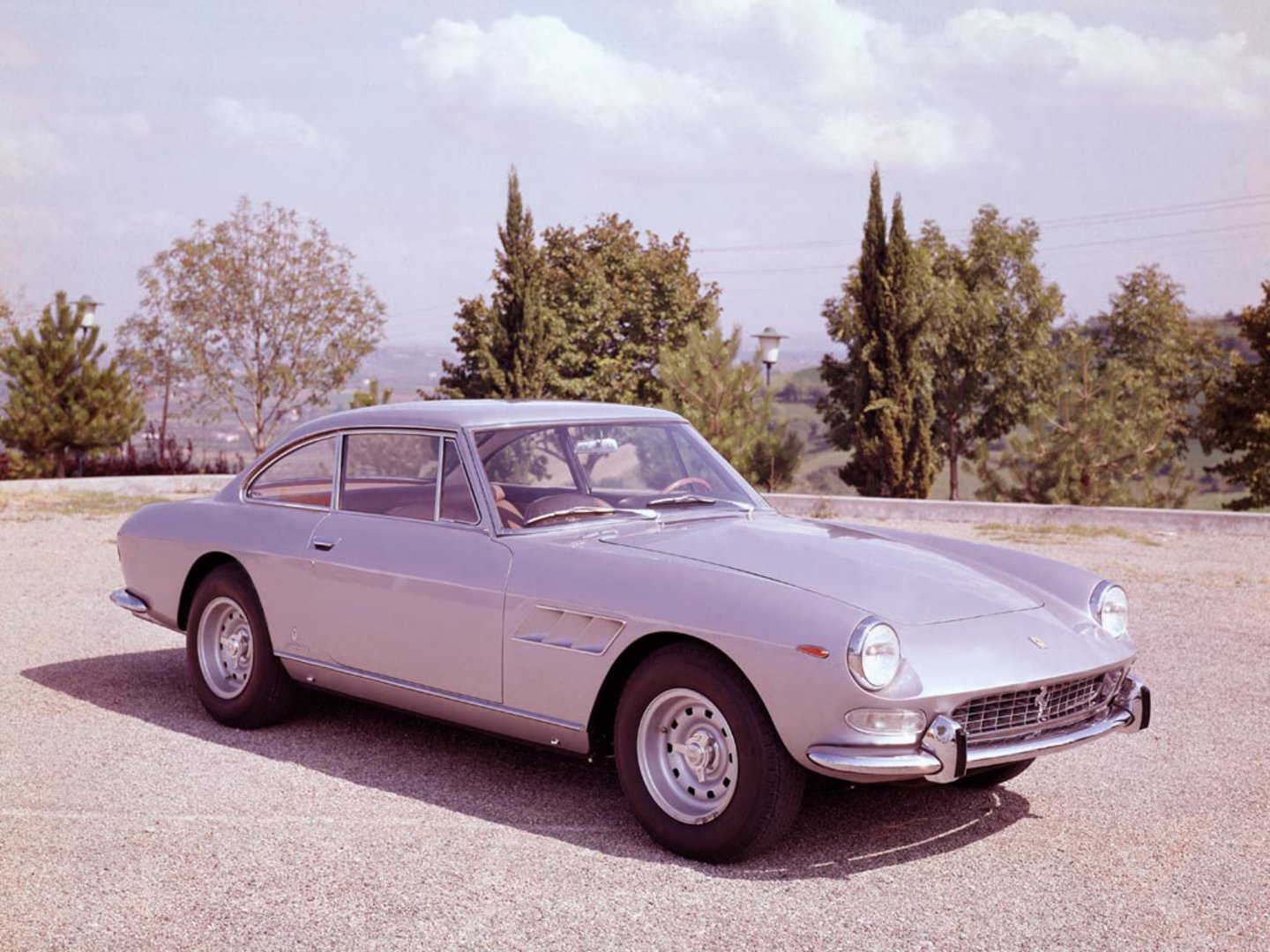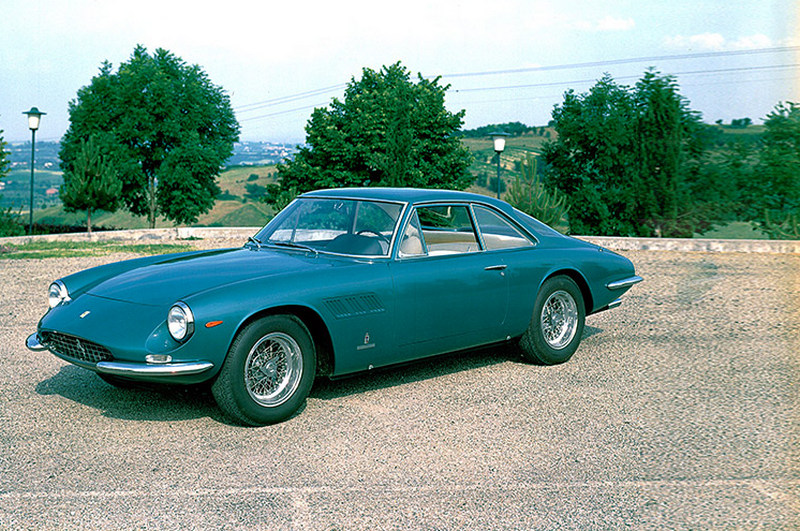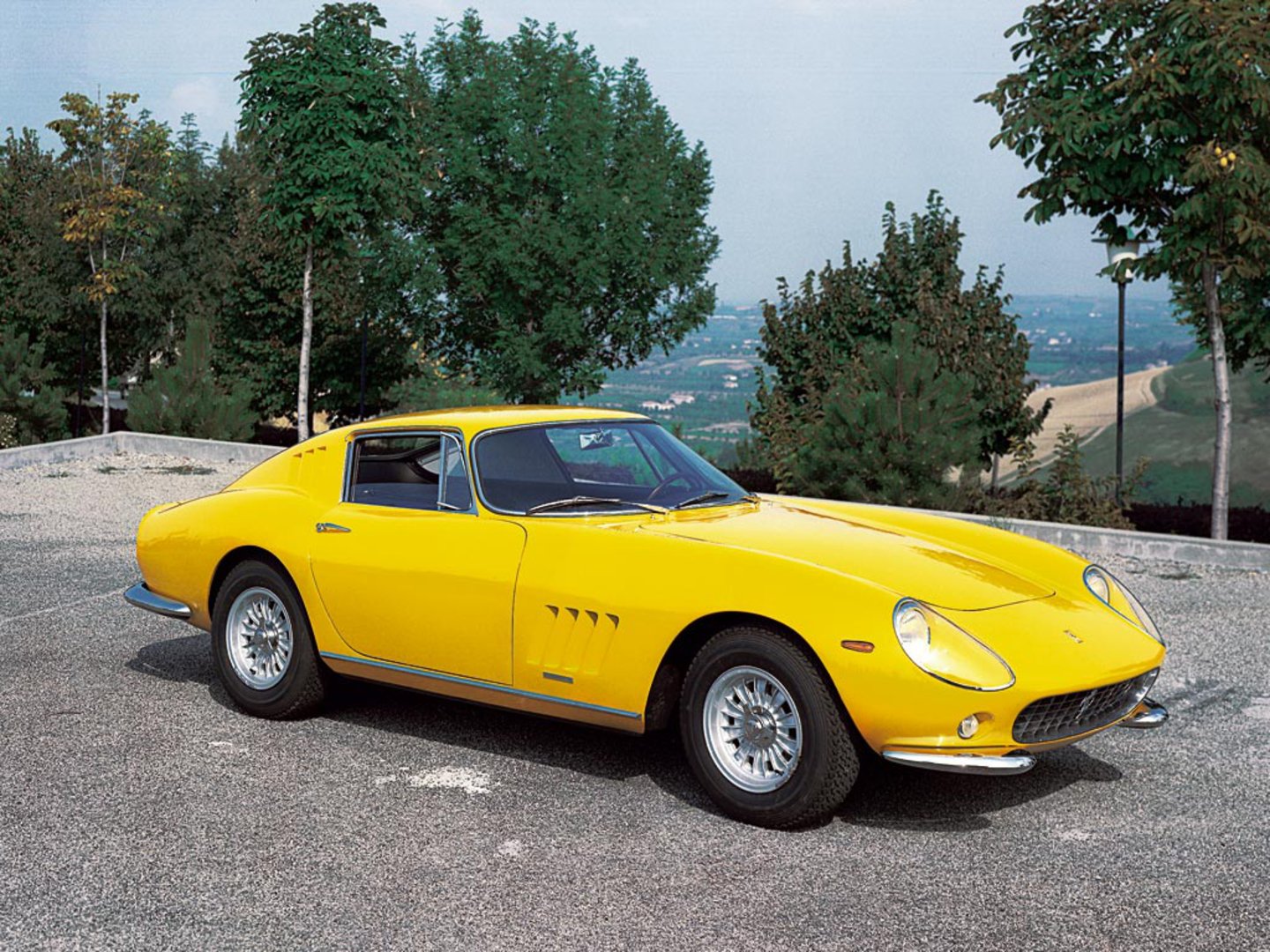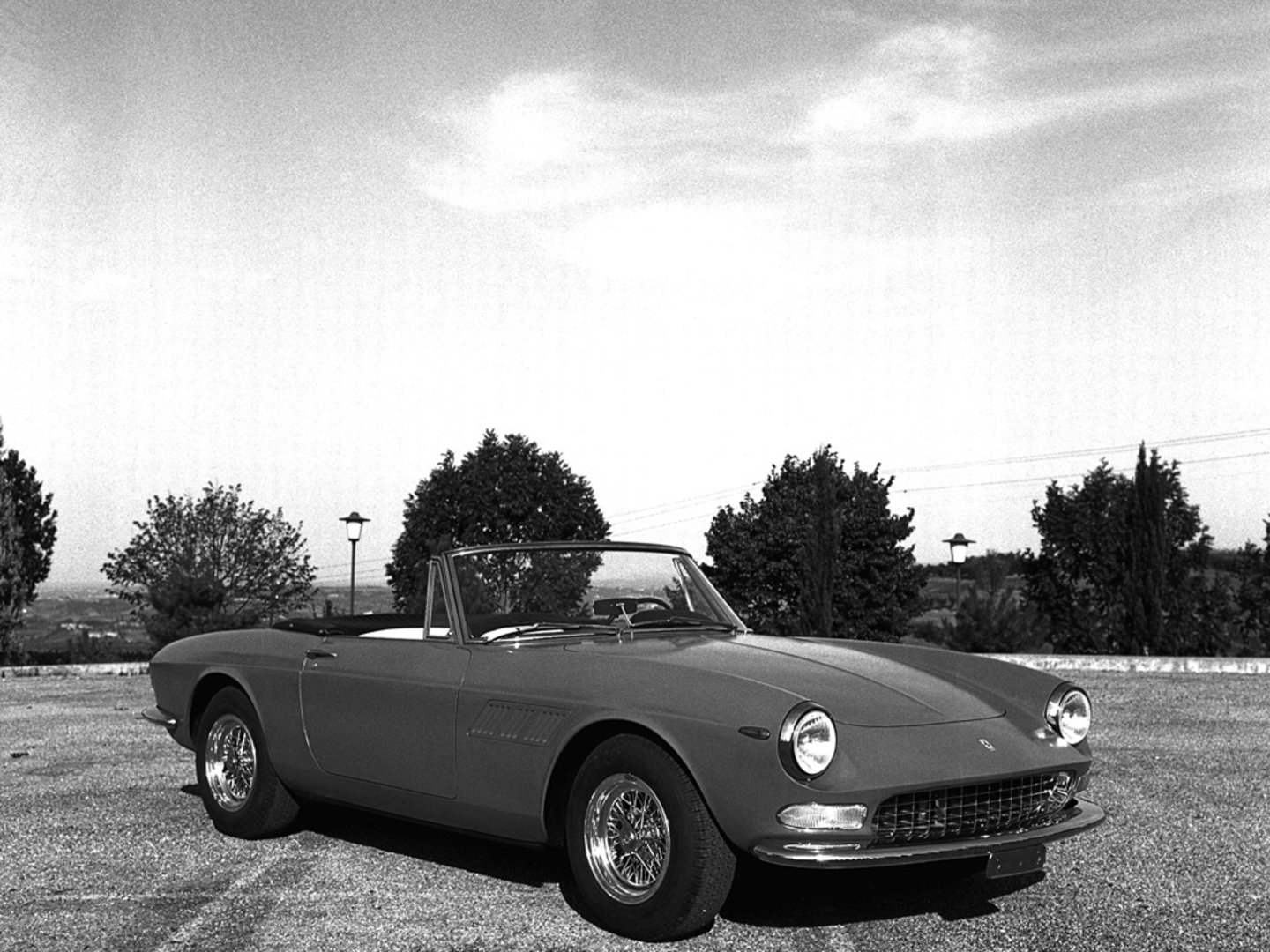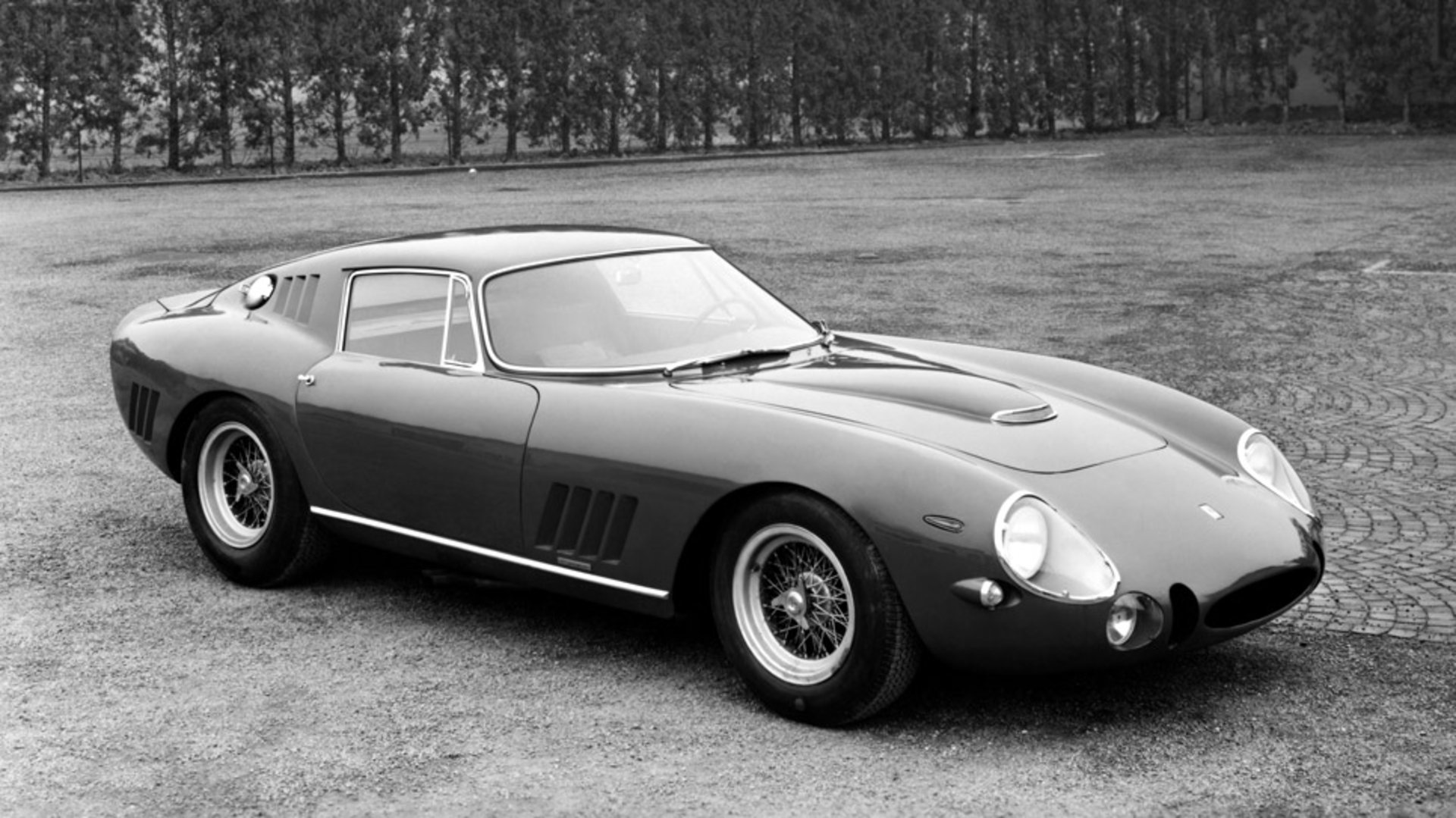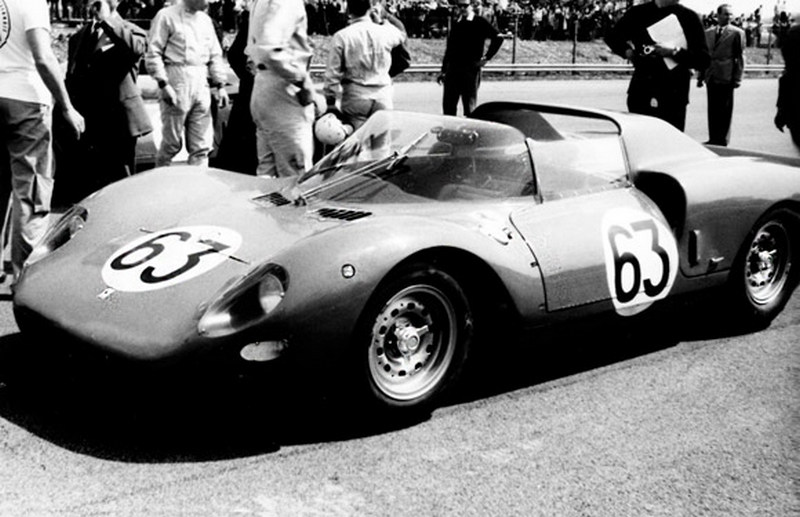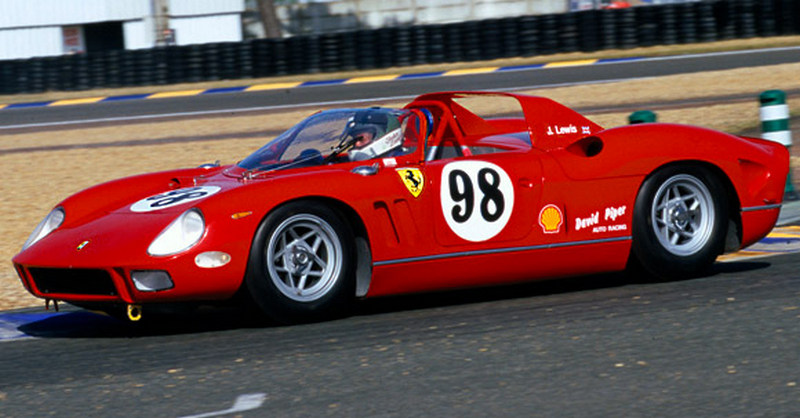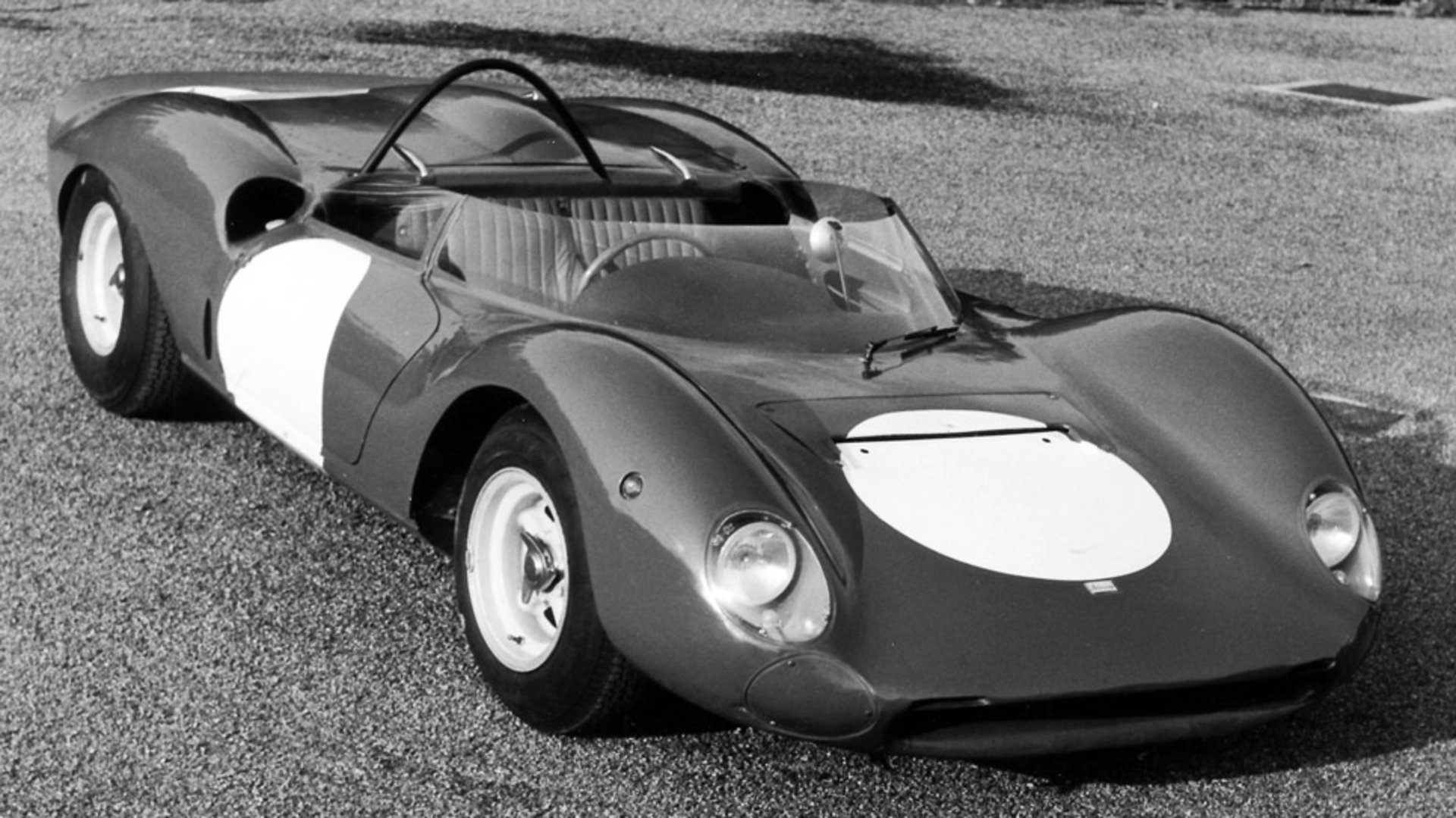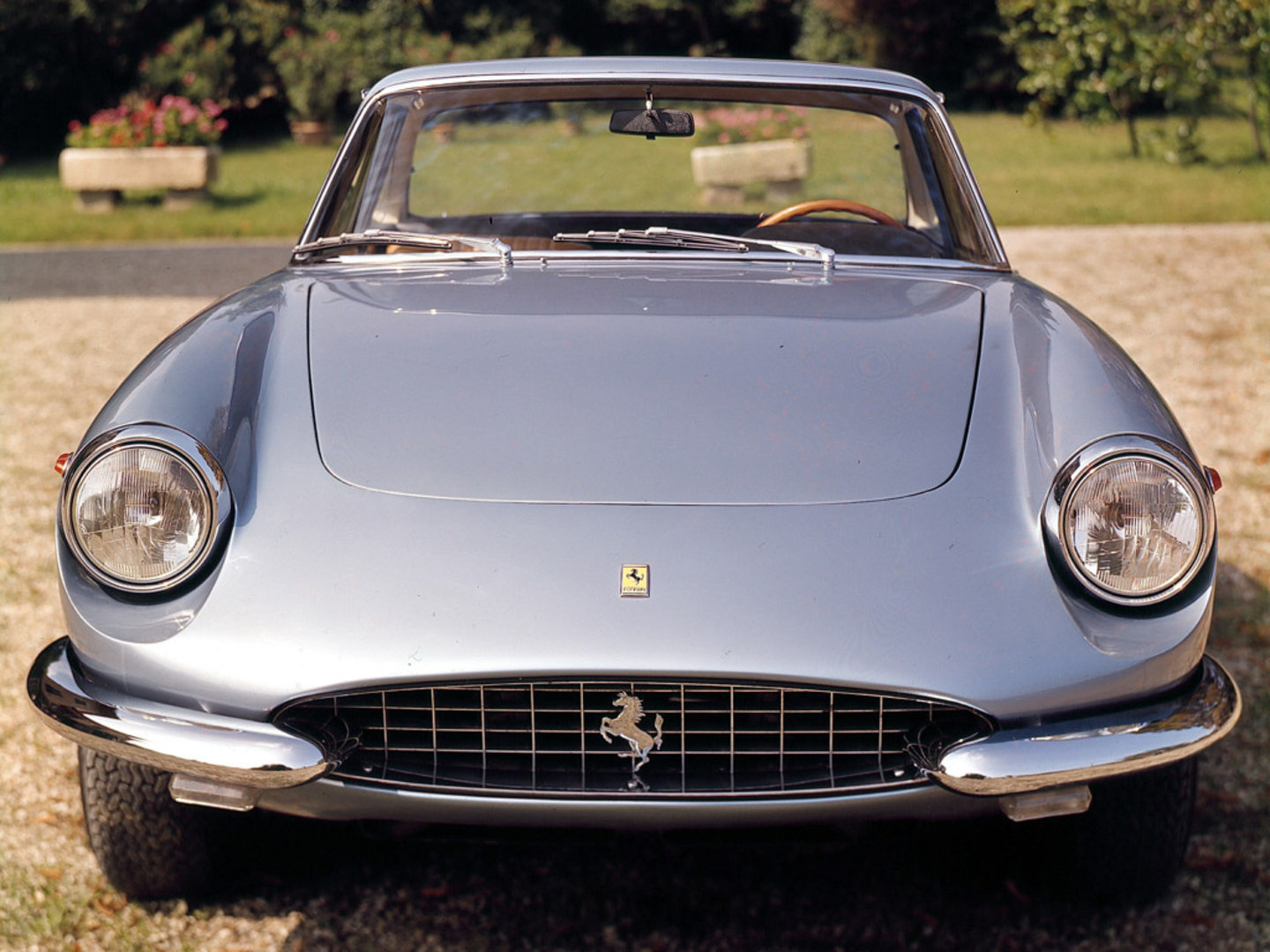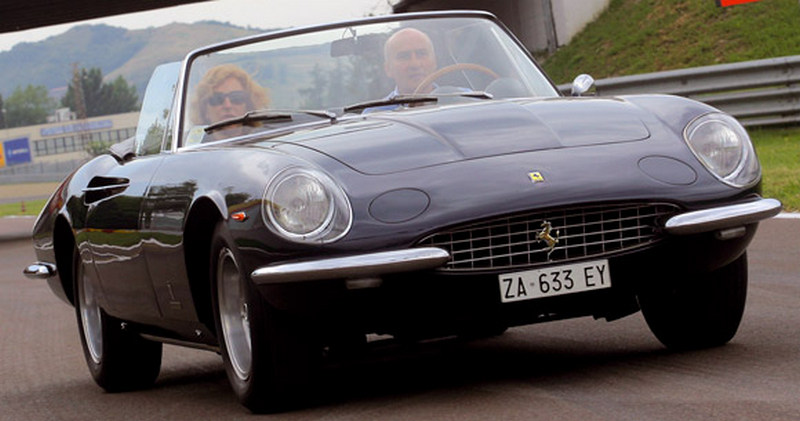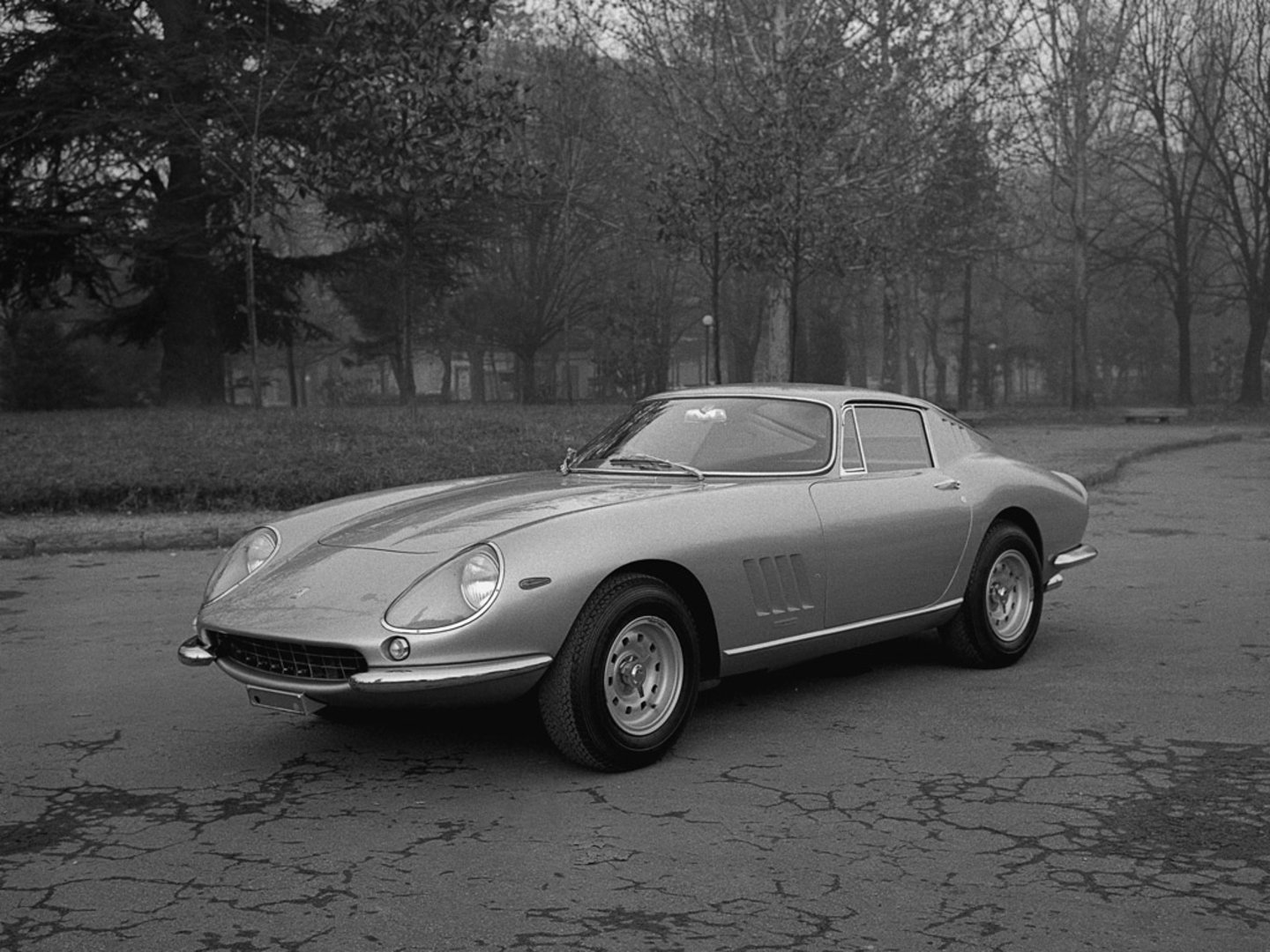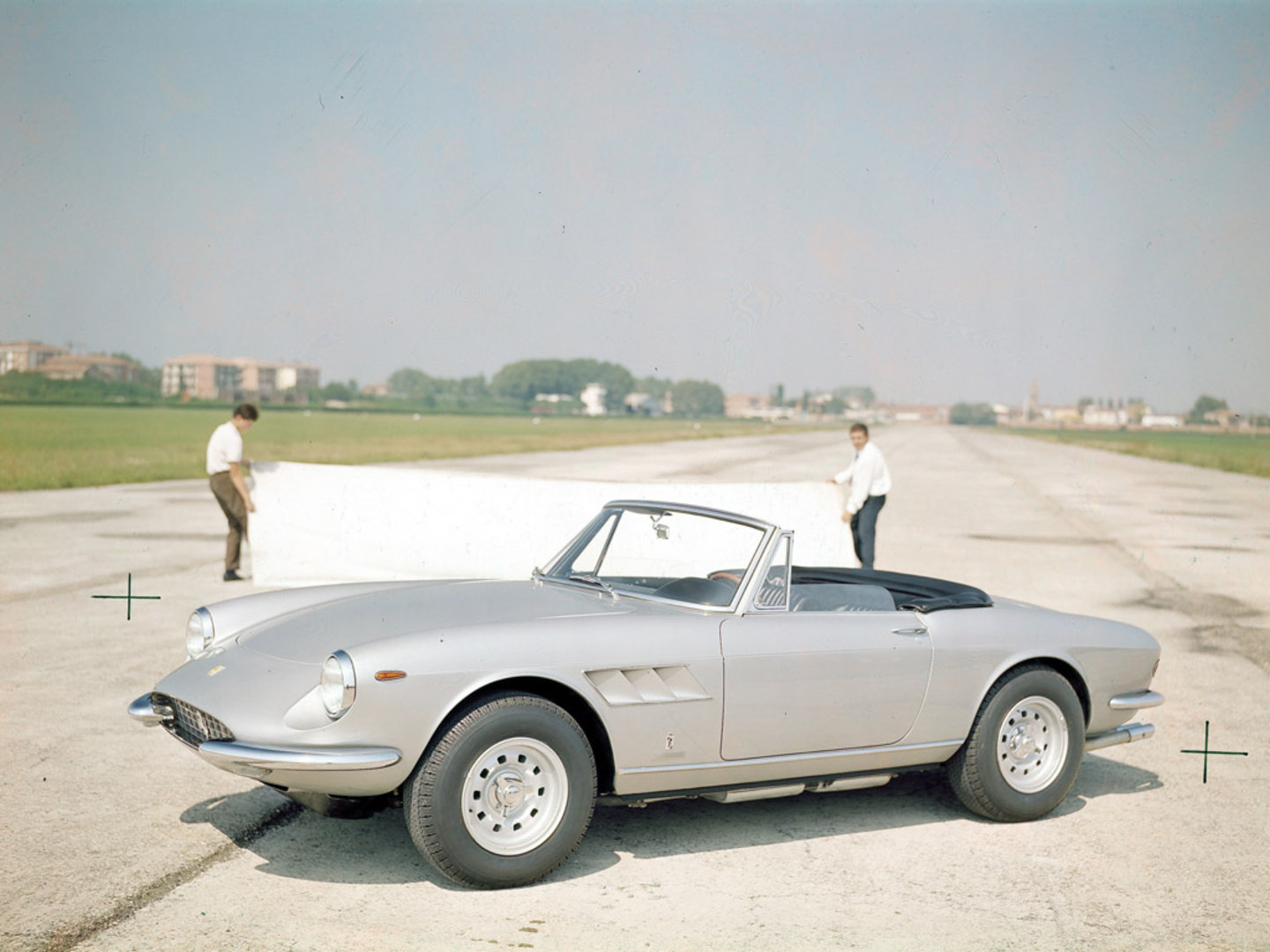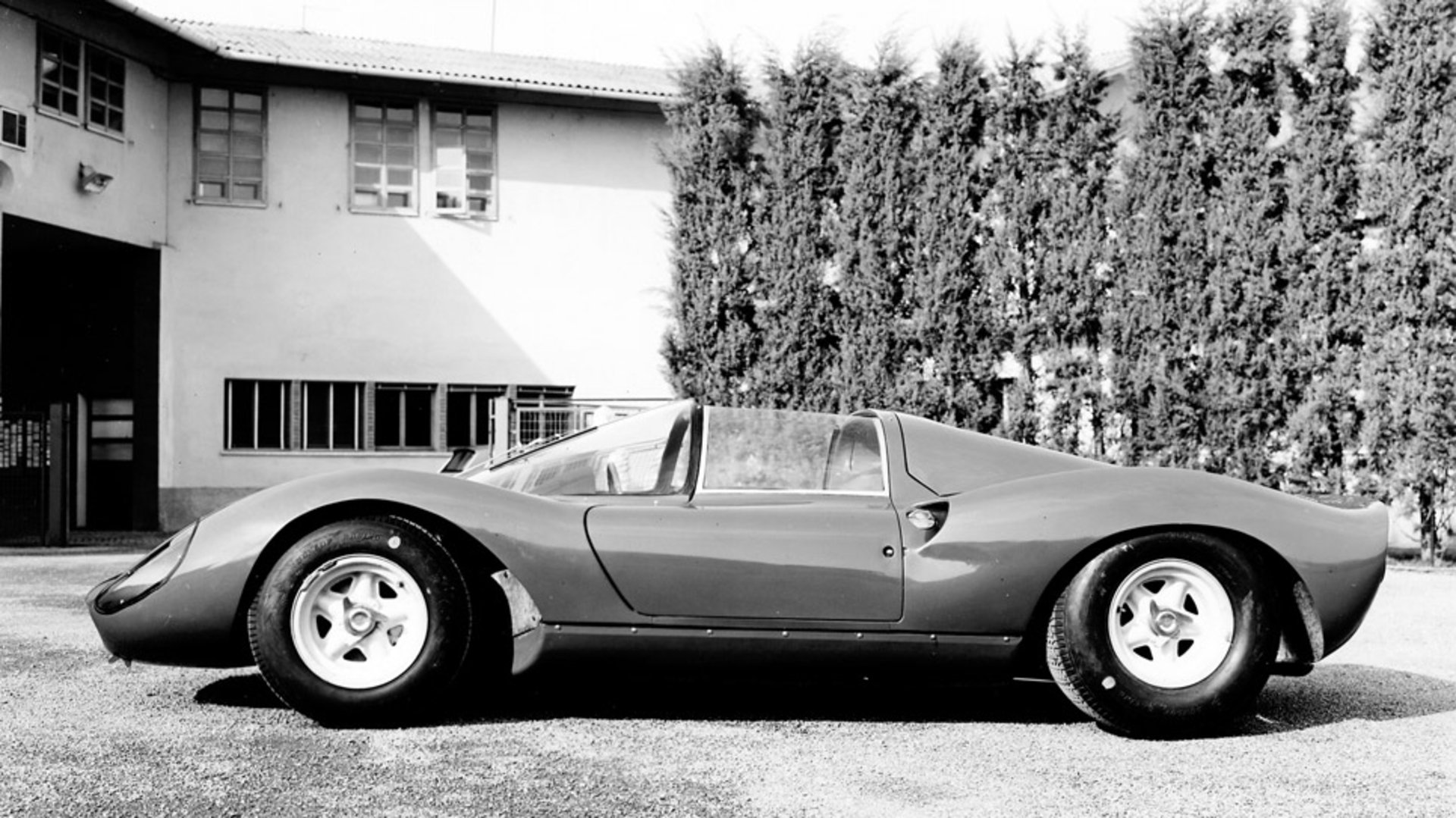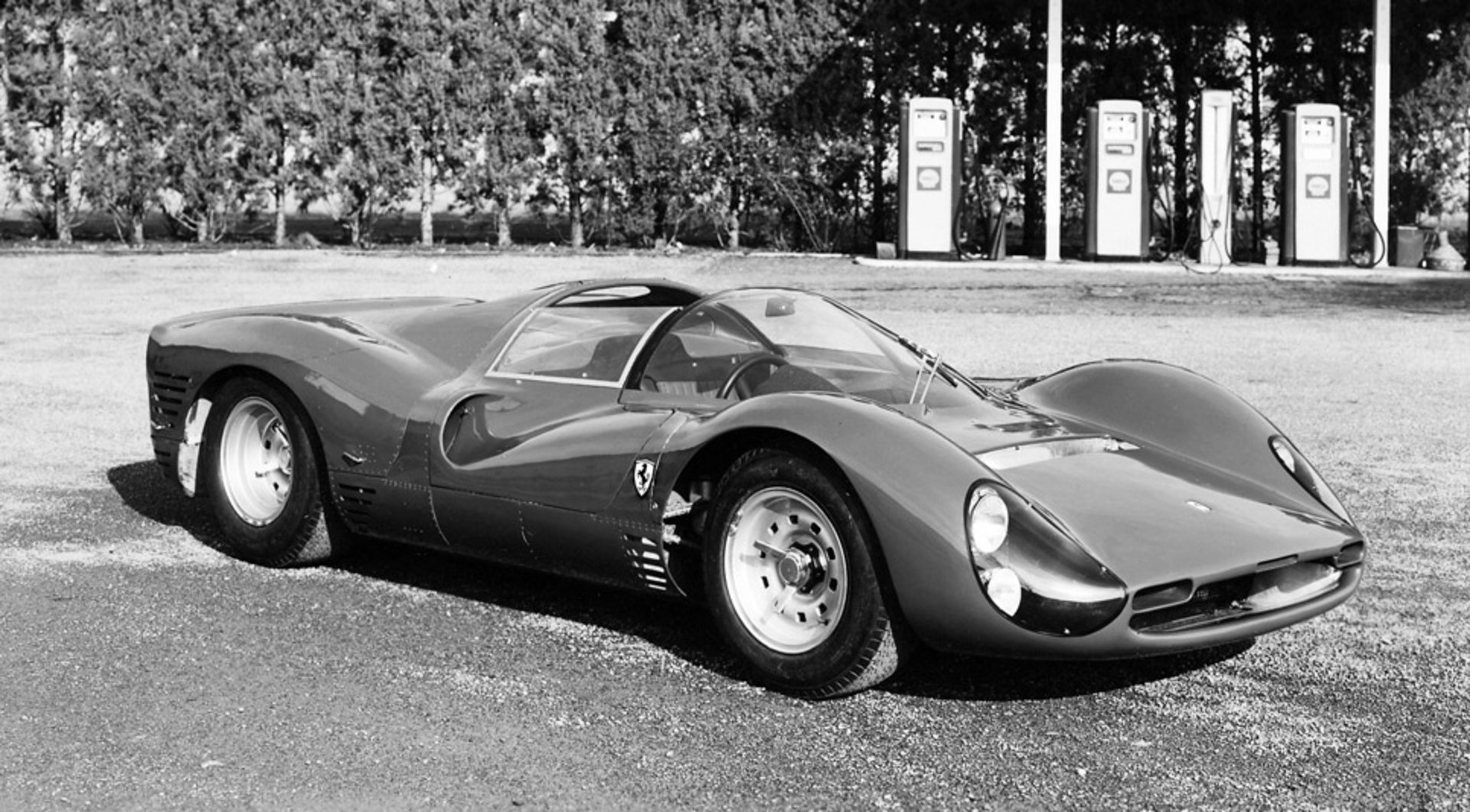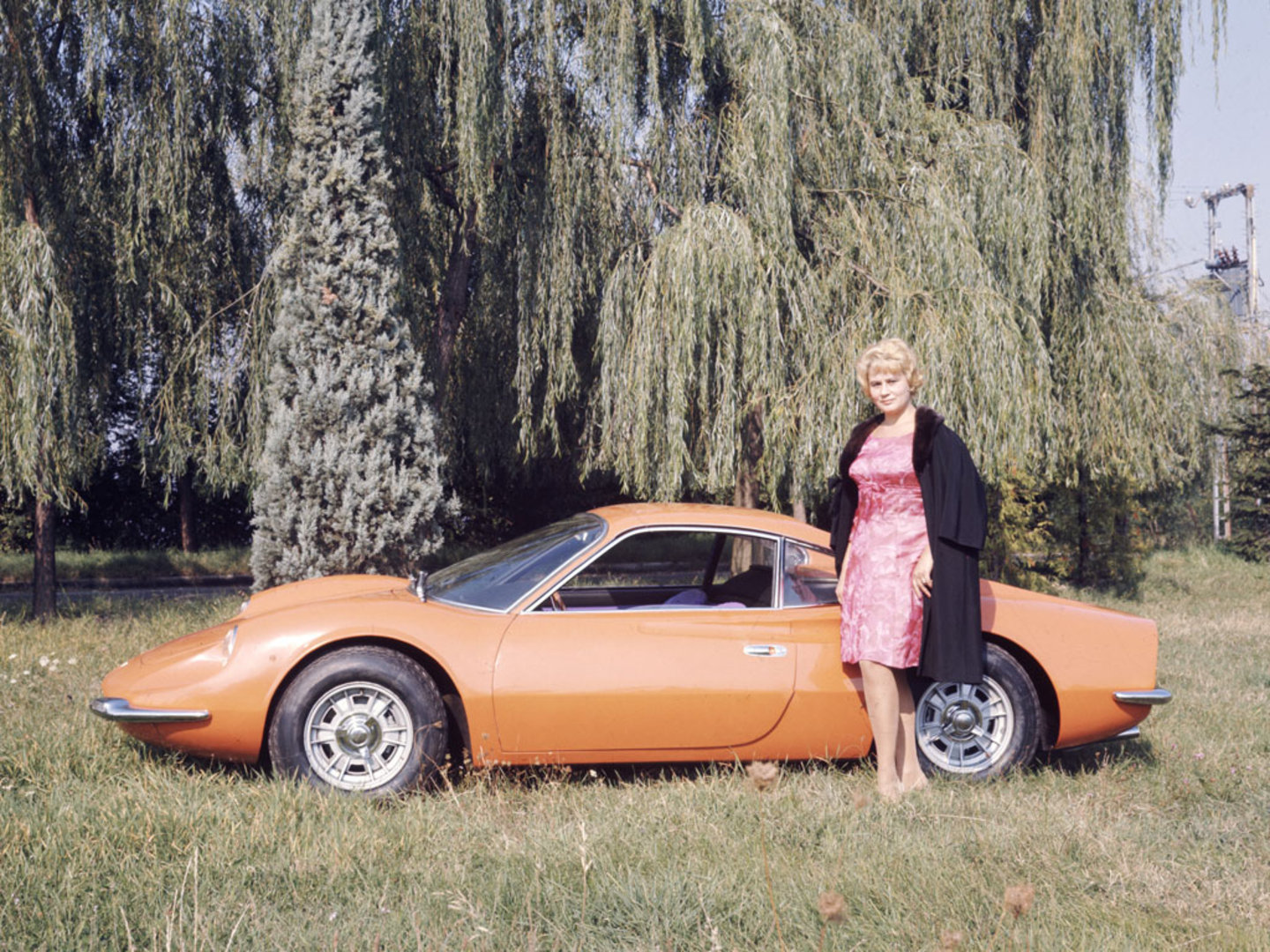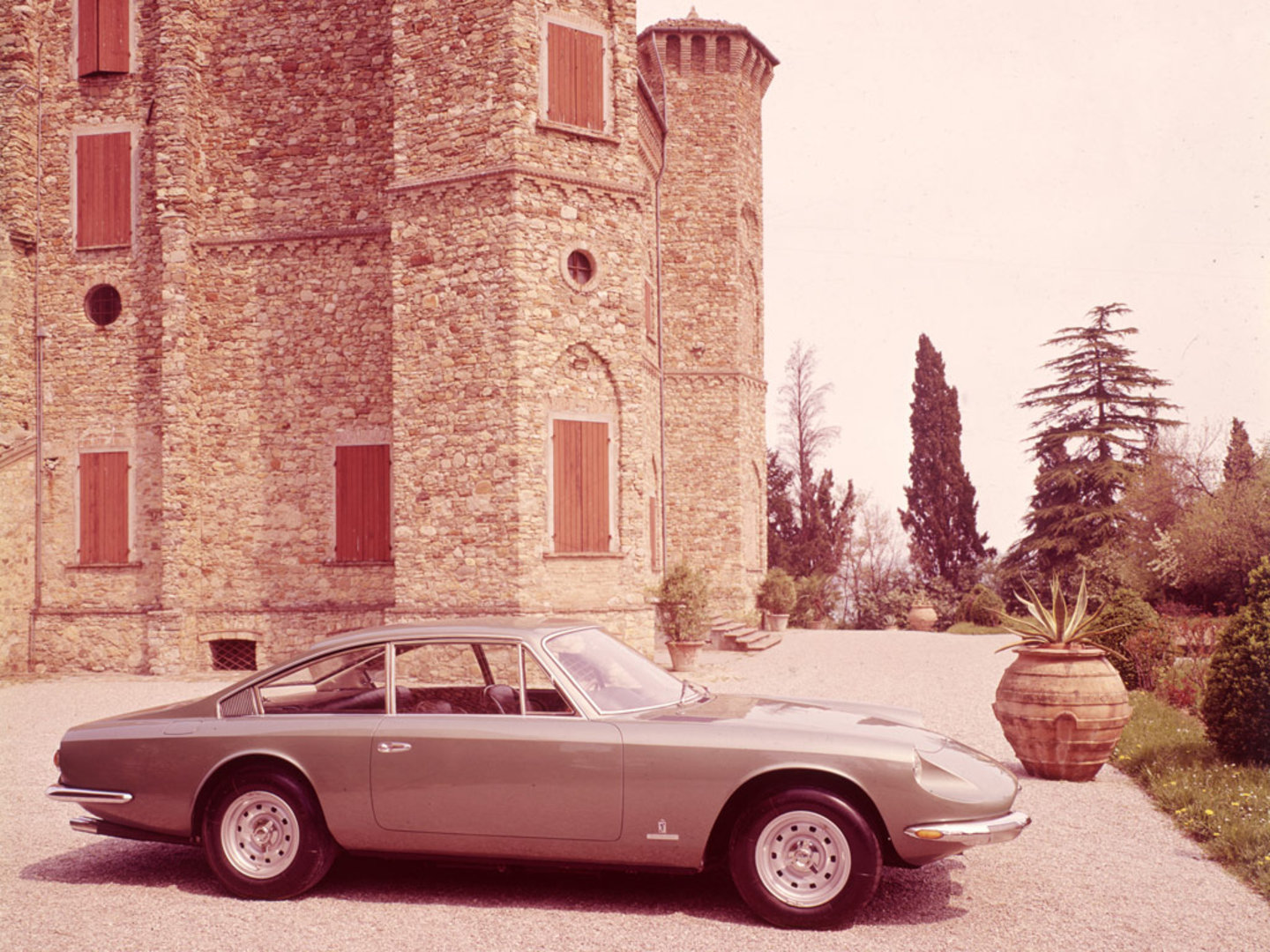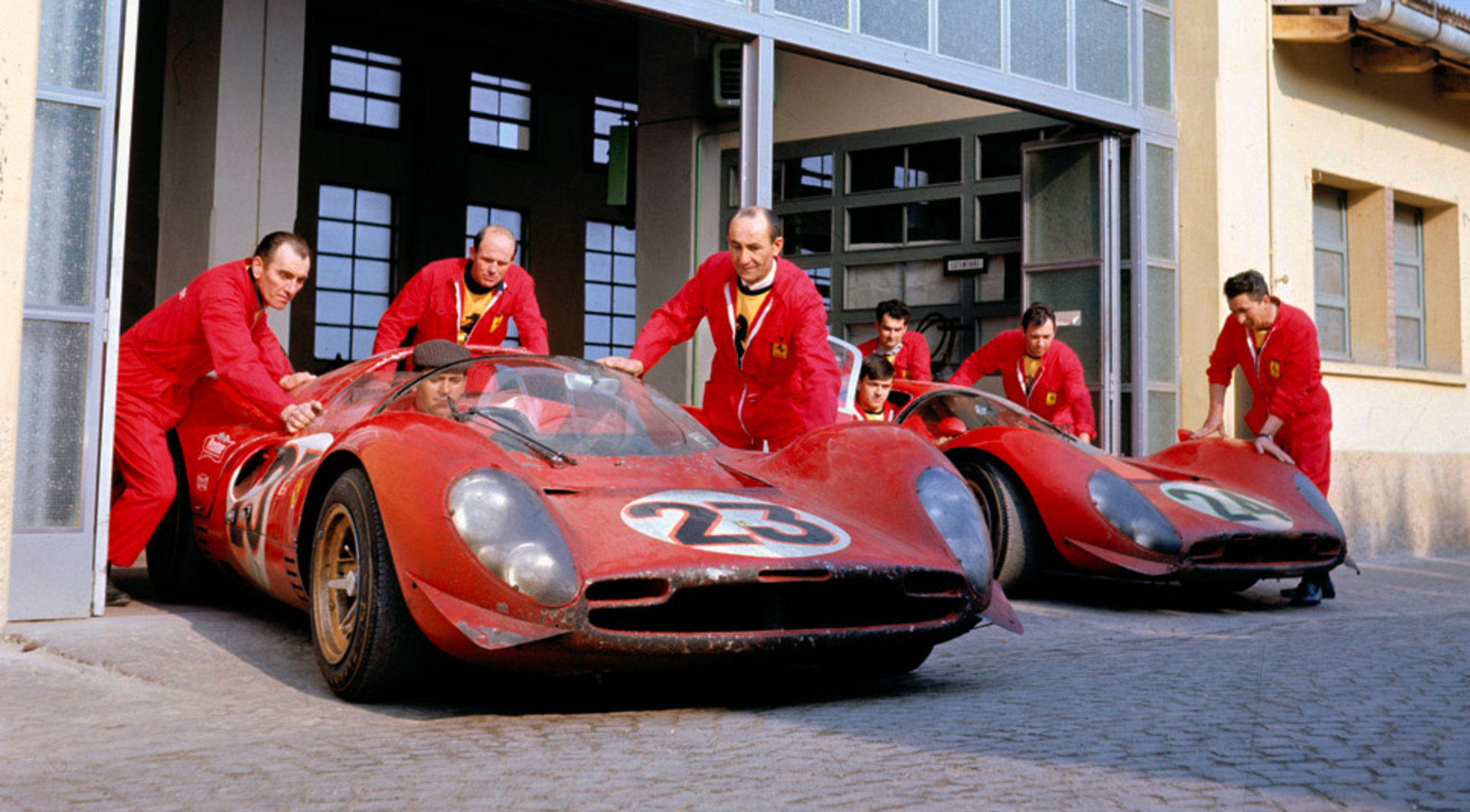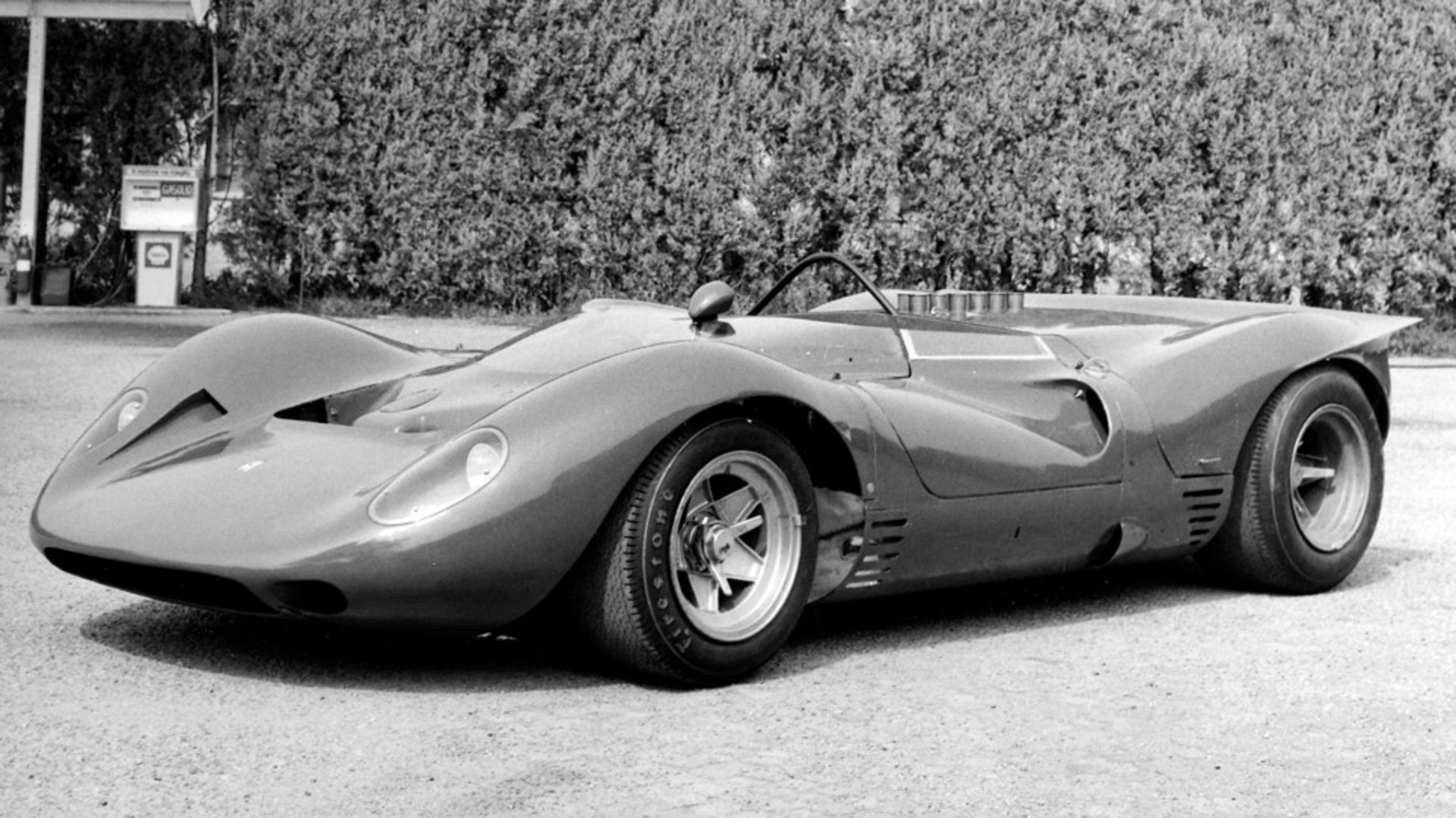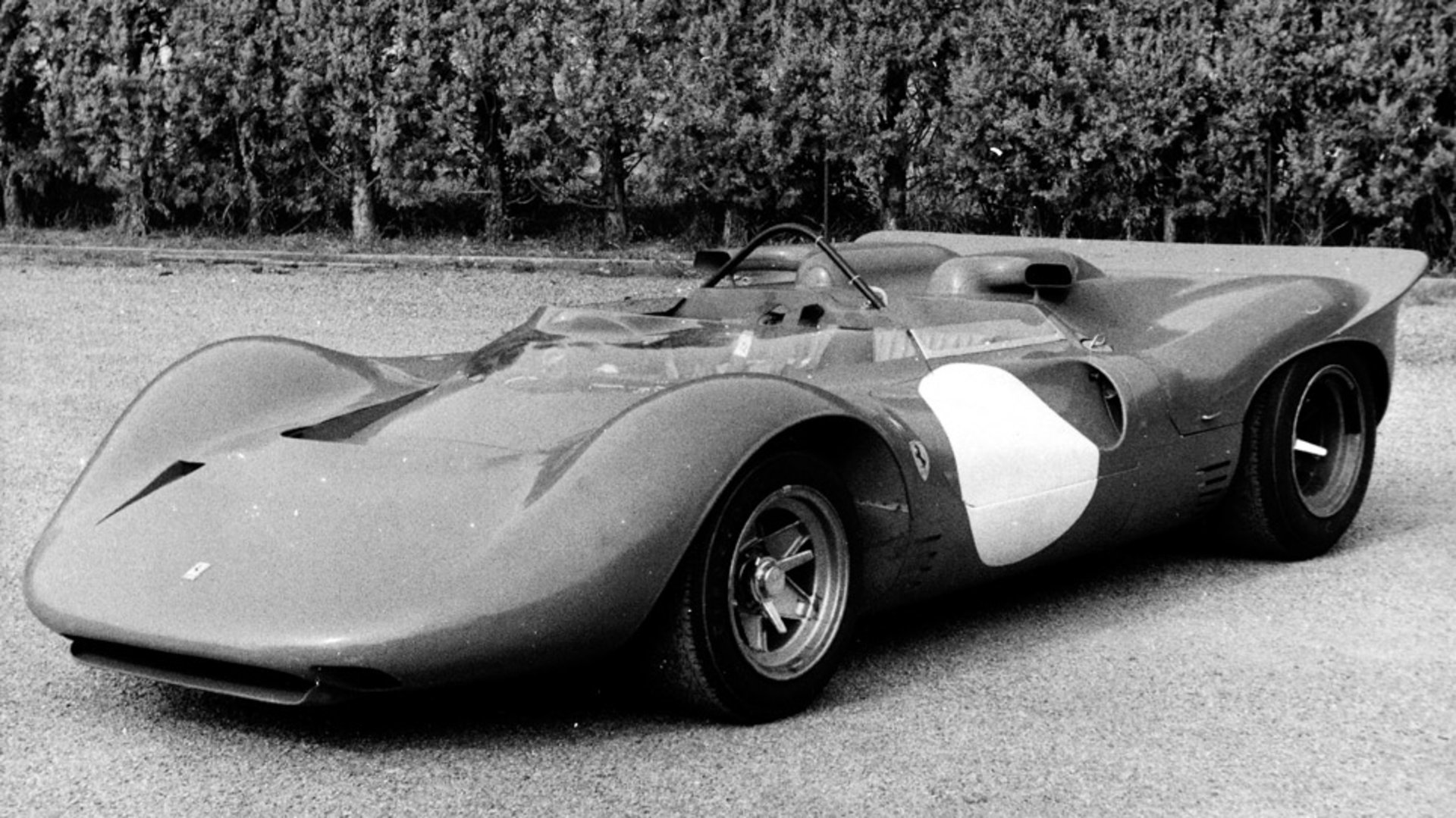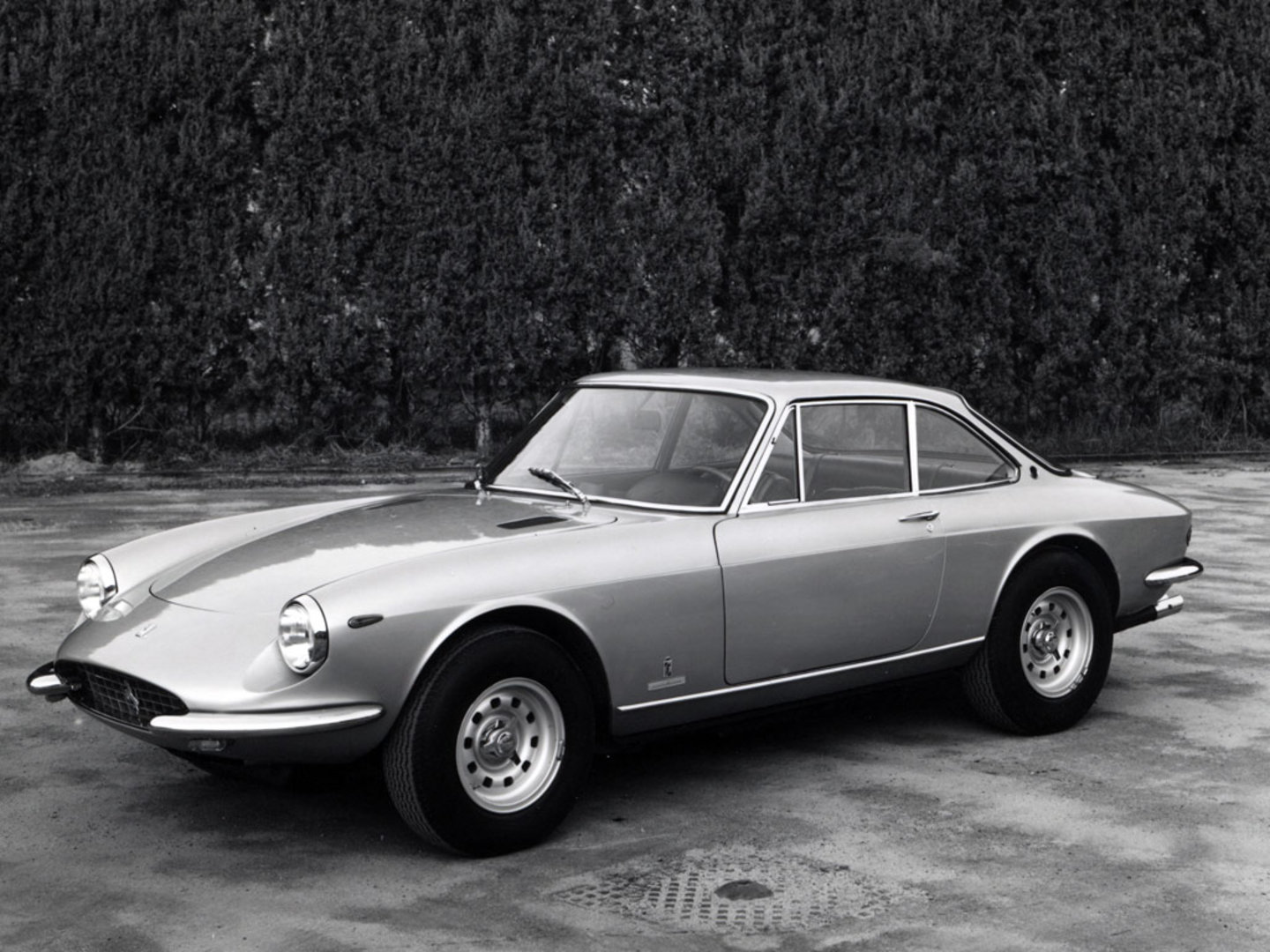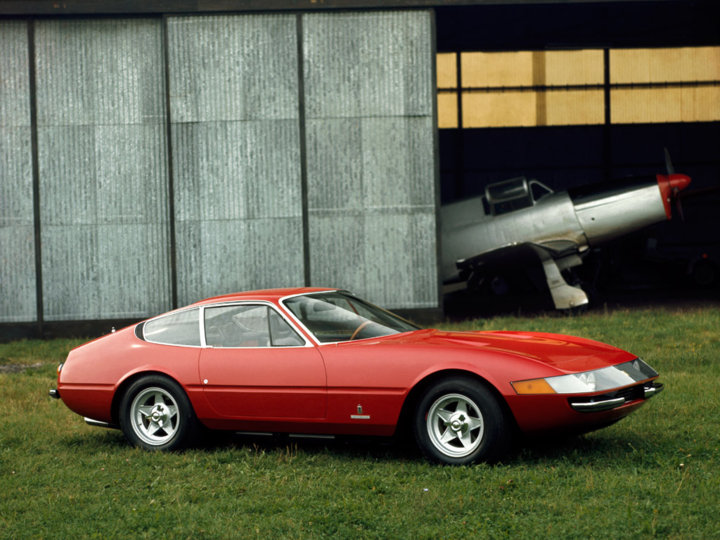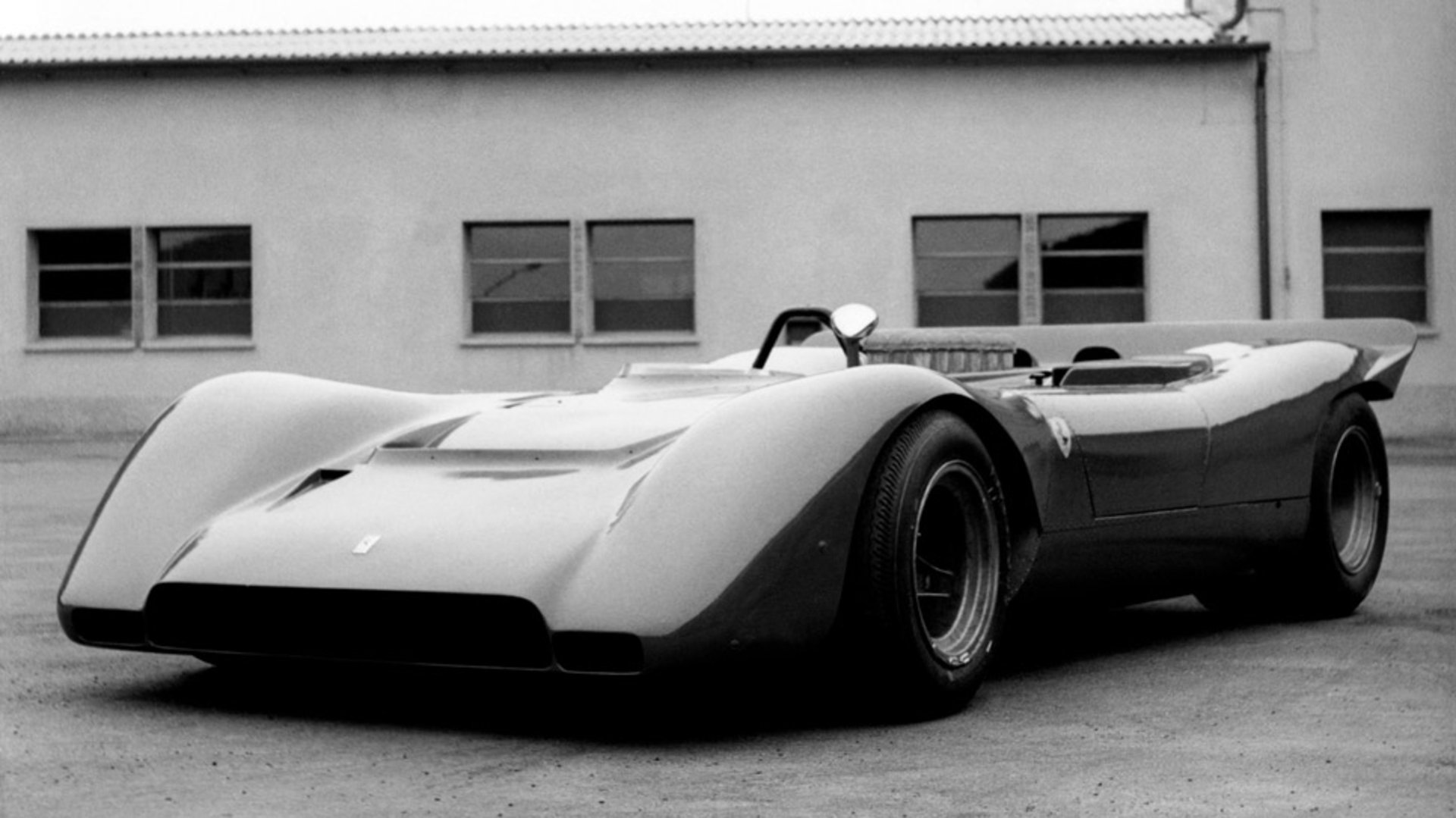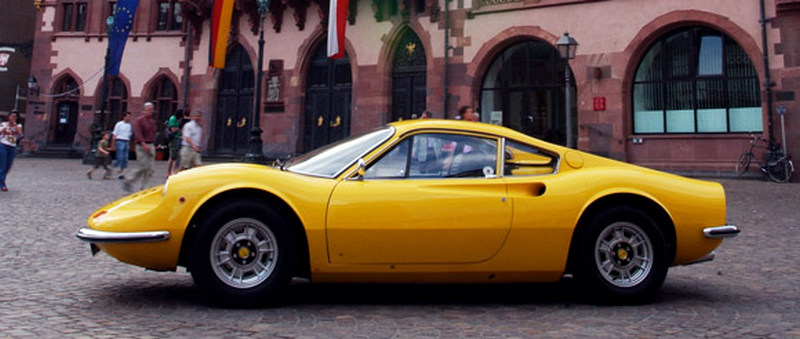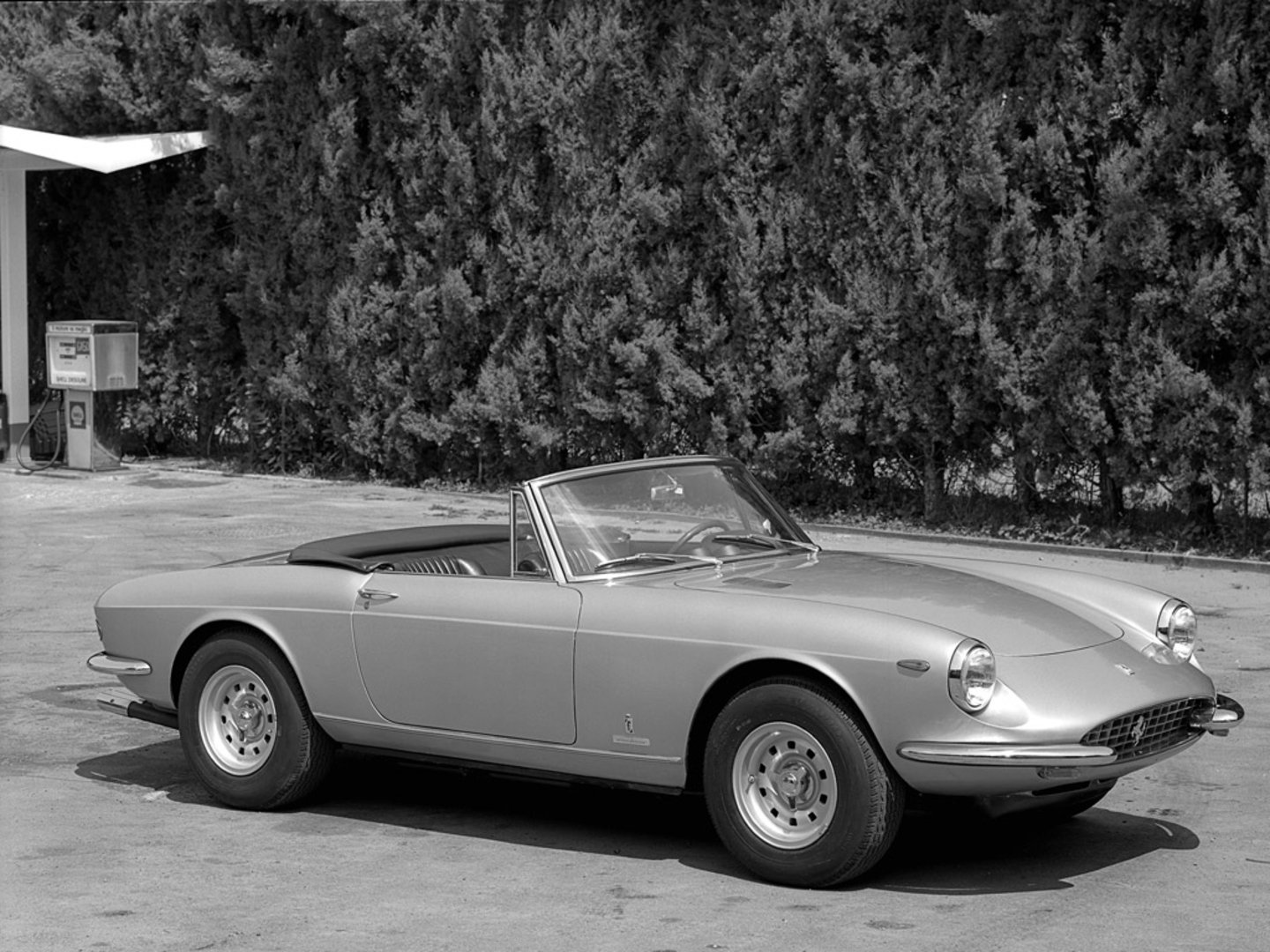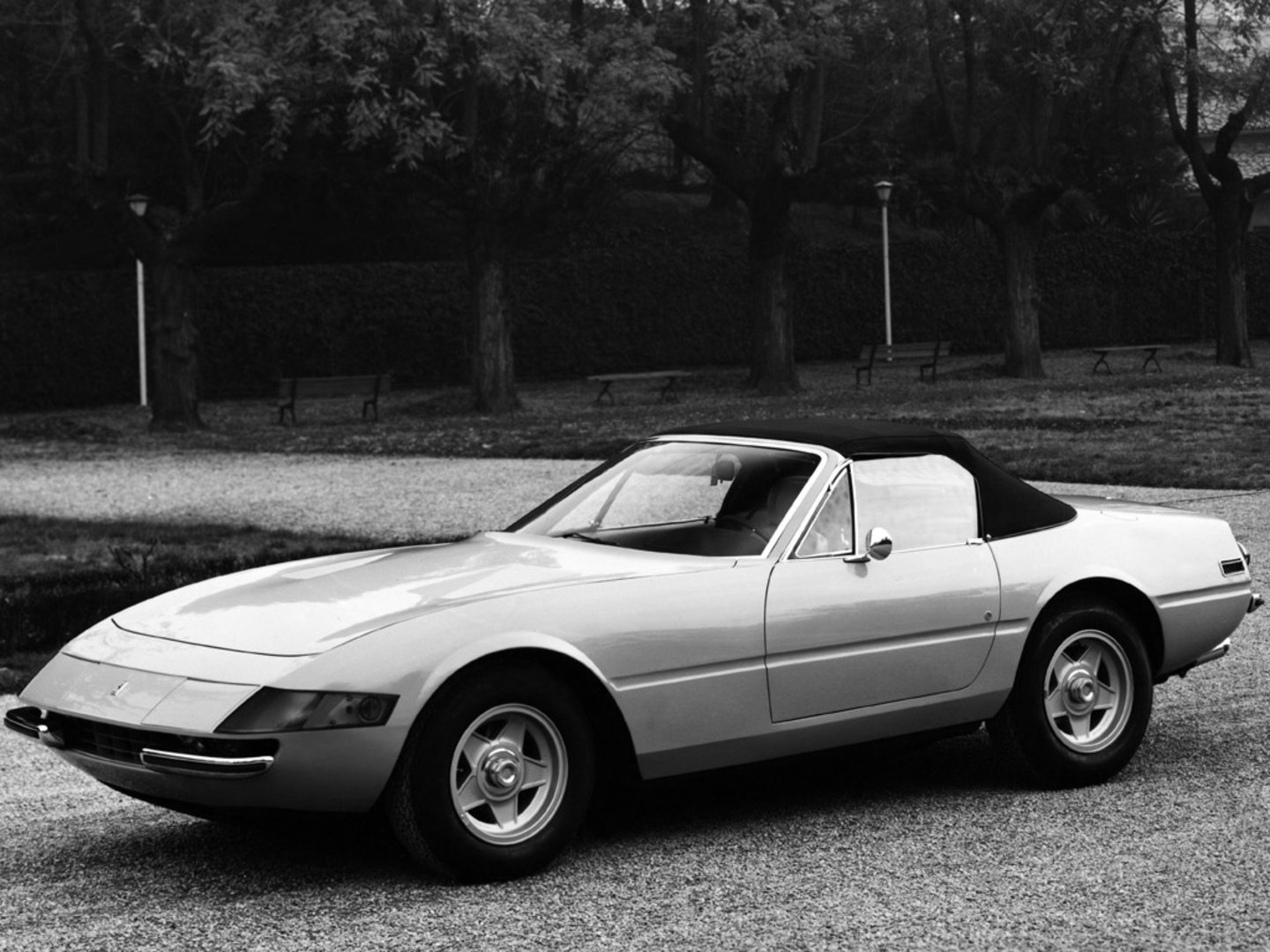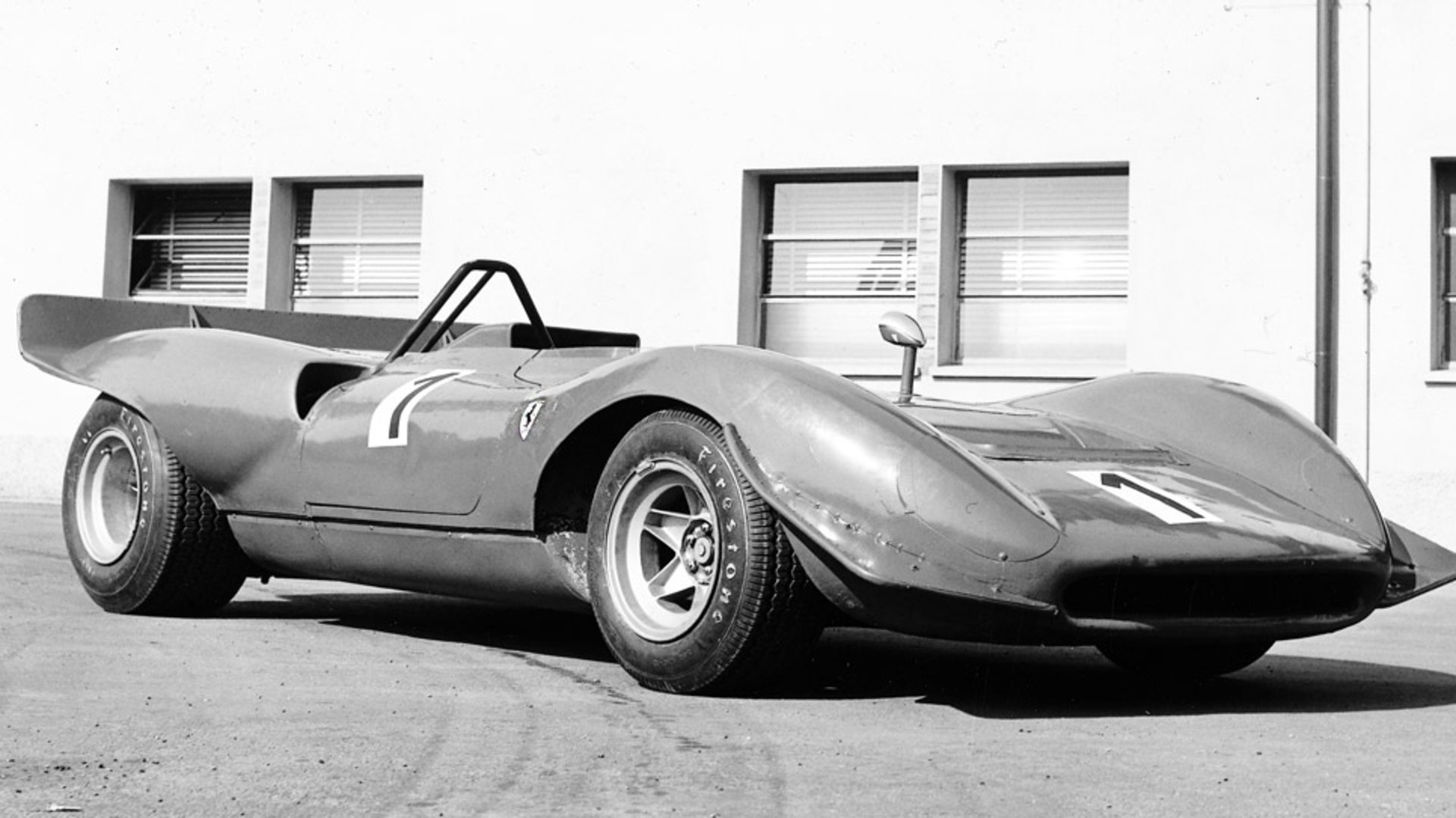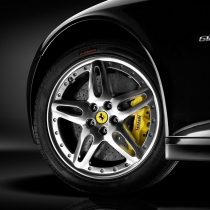We continue to recall the Ferrari’s history. In 1960 the company was restructured as a public corporation under the name SEFAC S.p.A. (Società Esercizio Fabbriche Automobili e Corse).
Early in 1969, Fiat took a 50% stake in Ferrari. An immediate result was an increase in available investment funds, and work started at once on a factory extension intended to transfer production from Fiat’s Turin plant of the Ferrari engined Fiat Dino. New model investment further up in the Ferrari range also received a boost.
Today Carrrs.com presents Ferrari cars of 60s.
Ferrari 400 Superamerica (1960)
Produced in two series between 1960 and 1964, the 400 Superamerica was one of those flagship models created in response to customer demand. A big, 4-litre V12, with loads of power and massive torque, sober yet luxurious interior, firm suspension settings that didn’t compromise on comfort, and a gearbox with overdrive. The cars were all bodied by Pininfarina and included spider, cabriolet and aerodynamic coupé versions, as well as the famous, one-off Superfast models: II, III and IV.
The 400 Superamerica series of cars were the successors to the 410 Superamerica models, and were produced between 1959 and 1964. This was the first time with a production road car that Ferrari deviated from the path of the model type number denoting the swept volume of a single-cylinder. The ’400′ designation referred to their total cubic capacity of four litres. All but two of the forty-six cars in the series were designed by Pininfarina (the company became Pininfarina in 1962), and the majority were in coupé form.
Ferrari 250 GT 2+2 (1960)
The 250 GT 2+2 was the first four-seater Ferrari to be produced on a large scale. Fitted with the Tipo 250 single overhead camshaft 3-litre V12, 957 of them were built. This model featured four speeds plus overdrive. The Pininfarina bodywork combined the results of the latest studies on aerodynamics with extremely elegant lines. The last fifty cars built (the final car left the factory at the end of 1963) were fitted with the 4-litre V12 engine from the 330 America.
The extra power on tap allowed the addition of accessories such as air conditioning, but externally the 4-litre cars were identical to the 250 GT 2+2.
Ferrari Dino 246 S (1960)
Just like the two-litre version, the Dino 246 S shared a similar styling to the 250 Testa Rossa of the same era, but was equipped with an engine derived from Formula 1. This version debuted in January 1960 at the Buenos Aires 100 km during the Temporada Argentina in the hands of Scarfiotti and Gonzalez. Two cars also took part in the Targa Florio, coming home second and fourth respectively. Although the Dino 246 S was subsequently used extensively by privateers, the official Ferrari works drivers only fielded the 250 Testa Rossa.
Ferrari 246 SP (1961)
The 246 SP caused uproar when it was unveiled at a special press conference in 1961 as it was the very first mid-engined Ferrari. The new mechanical layout was cloaked in highly innovative bodywork – developed as a result of Carlo Chiti’s wind tunnel tests – with a very low bonnet line. The new car’s first victory came the same year on the very difficult Piccole Madonie Circuit where Olivier Gendebien won the Targa Florio.
Ferrari 250 GTO (1962)
This was the car that summed up Ferrari philosophy best: the highest levels of performance and styling. Created by a team led by Giotto Bizzarrini, it owes its lines to research carried out in a wind tunnel.
Charisma came not only from its innumerable racing victories, but from the unique sum of its parts – stunning looks, a highly competitive chassis and a thoroughbred V12 engine.
The 250 GTO model was the pinnacle of development of the 250 GT series in competition form, whilst still remaining a road car. It made its public debut at the annual pre-season Ferrari press conference in January 1962, and was the only front engine model on display, with its monoposto and sports racing counterparts all having a mid-engine configuration.
Ferrari 250 GT Berlinetta lusso (1962)
The prototype of the 250 GT Berlinetta Lusso was presented at the 1962 Paris Motor Show, and thanks to Pininfarina’s timeless styling, was a great success with the public.
The Berlinetta Lusso was positioned between Ferrari’s more overtly racing models and up-market luxury offerings: essentially sporty in nature and with its V12 fuelled by three Weber carburettors, it still managed a few concessions to driving comfort. Scaglietti bodied all but a few of the cars produced.
Ferrari 196 SP (1962)
The traditional start of season press conference held in February 1962 saw the presentation of a whole series of rear-engined sports racing models with the result that the debut of the new 250 GT berlinetta, which later became the legendary 250 GTO, passed almost unnoticed. The sports models included the 196 SP which did not have a Dino engine, but was effectively a half of the 330’s V12 engine, from which it retained the bore and stroke. The 196 SP boasted the twin front air intakes first introduced on the single-seaters in 1961.
Ferrari 286 SP (1962)
This second model that debuted at the 1962 press conference is very similar indeed to the 196 SP both in terms of dimensions and styling. The body, in fact, was built to comply with the new FIA regulations with a windscreen and tail that were much lower than the previous 246 SP prototype’s. The engine was not a Dino as the angle between the two cylinder banks was 60° and not 65° and could really have been considered half a 12-cylinder. This model had no successor because the big V6 was abandoned in favour of the new V8 engines.
Ferrari 248 SP (1962)
This 2,458 cc barchetta was fitted with a single overhead camshaft V8 engine fed by four twin-choke Weber carburettors good for around 250 bhp. The tubular space-frame featured all-round independent suspension while the bodywork was very similar to the 246 SP’s. The 268 SP version was also fitted with a V8 engine the displacement of which, with the stroke increased to 71 mm, was upped to 2,650 cc.
Ferrari 268 SP (1962)
This 2,458 cc barchetta was fitted with a single overhead camshaft V8 engine fed by four twin-choke Weber carburettors good for around 250 bhp. The tubular space-frame featured all-round independent suspension while the bodywork was very similar to the 246 SP’s. The 268 SP version was also fitted with a V8 engine the displacement of which, with the stroke increased to 71 mm, was upped to 2,650 cc.
Ferrari 330 LM (1962)
The 4-litre berlinetta racers were built to comply with changing FIA regulations. The bodywork of the first two was very similar to that of the 250 GTO and, in fact, at times they were even referred to as the 4-litre GTOs. However, other models were subsequently built with Pininfarina bodywork with styling similar to the Turin coachbuilder’s other models and resembled the 250 Lusso from some angles, although the nose was closer to the 250 GTO. The 330 LMs saw plenty of competition use, especially at the 24 Hours of Le Mans from which they take the LM suffix to their name.
Ferrari 330 TR (1962)
This one-off was the last Ferrari front-engined sports car to win the classic Le Mans 24-hour race. The 330 TRI pulled off this feat in 1962, courtesy of the legendary pairing of American Phil Hill and Belgian Olivier Gendebien. The 330 TRI was built on a modified TR chassis with a longer wheelbase and independent rear suspension. It was powered by a single cam-shaft Type 330 V12 four-litre that produced 390bhp.
The line of the 330 TRI’s bodywork was that of the classic 1950s racing barchettas. Fast and reliable, after its triumph in the race for which it was built, it was sold to Chinetti’s NART team and went on to take part in other races.
Ferrari 250 LM (1963)
Presented at the Paris Motor Show in October 1963, this was the berlinetta version of the 250 P prototype, sharing the same chassis and running gear with just minor modifications. The FIA’s refusal to homologate it as a GT car damaged its sales potential and the decision forced the car to compete with true prototypes, thus decreasing its chances of victory. On the other hand, it did extend the life of the 250 GTO on the racing circuits.
Ferrari 330 GT 2+2 (1964)
The 330 America was replaced by the 330 GT 2+2, which was unveiled at the Brussels Show. It was fitted with the new 4-litre Type 209 V12, which sported a slightly longer engine block than the 400 SA series from which it was derived. The 330 GT 2+2′s elegant line was the work of Pininfarina, and two series were built. These differed principally in the front end treatment; the first series (1963-1965) having four headlights and the second (1965-1967) just two. Around 1,000 examples were built in all.
The 330 GT 2+2 coupé was presented at the annual Ferrari pre-season competition press conference in January 1964, making its public appearance at the Brussels Salon later that month. It was the replacement for the 250 GTE 2+2 model, which had ended its production run with a series of one hundred models known as the 330 America: visually identical to the 250 GTE, but fitted with a 4-litre engine.
Ferrari 500 Superfast (1960)
This model, targeted at clients looking for uncompromising performance in a luxury car, was presented at the 1964 Geneva Motor Show. Derived from the 400 Superamerica, it was fitted with a special engine which benefited from the work of both Colombo and Lampredi. With three 40 DCZ/6 Webers, it boasted 400 bhp, which placed the car at the top of its class. Twenty-five units with a 4-speed gearbox were built during the first series. In 1966 a second series of twelve cars came out, which had additional speed.
The 500 Superfast was presented at the 1964 Geneva Salon, and would have a limited production run into 1966. It would also be the last low volume production coupé produced by Ferrari, in a series that had started with the America and Superamerica of the fifties and early sixties. As the series production car output increased in number and uniformity, the tooling necessary for small series runs was becoming less viable, despite the greater sales price.
Ferrari 275 GTB (1964)
The most important new features of the 275 GTB were the rear-mounted gearbox and independent rear suspension. To improve road-holding, a 280 bhp V12 engine with dry sump lubrication was used; as the overall height of the engine was reduced, it could be fitted deeper in the chassis to lower the centre of gravity.
The car came with standard light alloy rims. Including the I and II series, around 450 cars were built by Scaglietti. Some of these, destined for racing, came in aluminium with racing suspension and six Weber carburettors, and are known as the 275 GTB/C. The 275 GTB berlinetta replaced the 250 GT Lusso at the 1964 Paris Salon, marking two landmarks in Ferrari’s road car production history.
Ferrari 275 GTS (1964)
The Pininfarina-designed spider version of the 275 GTB shared the same independent rear suspension and rear-mounted gearbox. The V12 once again was fitted with dry sump lubrication, but the engine developed around 20 bhp less; given the type of car and its target clientele, torque and flexibility were favoured over maximum power. While the 275 GTB wore alloy rims, the GTS was fitted with wire wheels, creating a more elegant look.
The 275 GTS spider was presented alongside the 275 GTB at the 1964 Paris Salon, marking the return of an open model to the Ferrari catalogue after nearly two years, since the cessation of 250 GT California production in early 1963.
Ferrari 275 GTB Competizione (1965)
At least two prototypes of this model were built in 1965. The story goes that the bodywork, created as always by Pininfarina, was supposed to have been for the new berlinetta. However, Enzo Ferrari scotched the proposal and the cars already built were initially put into storage. They were later reworked and lightened to make them more suitable for racing and went on to take part in the Targa Florio, the 1000 km at the Nürburgring and the 24 hours of Le Mans in 1965.
The latter was a truly tough race and the Ecurie Francorchamps car, with Willy Mairesse and “Beurlys” (the pseudonym of millionaire Jean Blaton), came home third overall behind two 250 LMs and also took first in the GT class. In 1966, a small series was built for customers which featured the same bodywork as the production model.
Ferrari 275 P2 (1965)
The various models in the P series were developed over a period of four years beginning in 1964. The first development came in 1965 with the 275 P2 which stood alongside the very similar 330 P2 from which it differed only in terms of the latter’s larger displacement. Thanks to Parkes and Guichet, the car made a very successful debut at Monza ahead of its more powerful stable mate in the hands of Surtees and Scarfiotti. Avant-garde models were always used by the Ferrari’s official team drivers and were involved in some very hard fought battles with their rivals.
Ferrari 330 P2 (1965)
Four litres is as large as Ferrari ever went with developing its sports-prototypes, even when confronted with competition from bigger, 7-litre American engines. To make up for this performance gap, the 330 P2’s V12 relied on very sophisticated construction with twin overhead camshafts per cylinder bank. Similarly, the chassis was strengthened by panels attached to the outside of the spaceframe and the suspension showed distinct F1 single-seater overtones. After a rather patchy season, the car made way for its successor, the 330 P3.
Ferrari 365 P (1965)
The 365 P was the exception to the 4-litre rule for the official works cars. In fact, it was built for dealers’ teams, and the smaller output was made up for by the larger displacement and greater construction simplicity – a fact not to be underestimated considering the cars had to be maintained outside the factory’s racing department. The engine had a single overhead camshaft per cylinder bank and single-plug ignition while the chassis was similar to the P2’s.
Ferrari Dino 206 SP (1965)
This model could best be described as an open-top version of the Dino 166 P with a bigger engine. This one-off barchetta was specifically designed for hillclimbs in the European Mountain Championship. In fact, its power and light weight gave Ludovico Scarfiotti four wins and allowed him to take the title.
The 206 S presented a year later was derived directly from the Dino 206 SP.
Ferrari 330 GTC (1966)
This model slotted in between the 275 GTB Berlinetta, whose chassis it shared, and the more tranquil 330 2+2 Coupé, from which it inherited its 4-litre V12 engine. Presented at the 1966 Geneva Motor Show, it was an instant success: Pininfarina’s extremely elegant bodywork took after the 500 Superfast at the front and the 275 GTS at the rear. The 330 GTC remained in production until the end of 1968: 600 were built.
The 330 GTC Coupé was unveiled at the 1966 Geneva Salon, as an additional model to the Ferrari production car range. It was designed by Pininfarina, and was assembled at their works in Turin, before being delivered fully trimmed to Ferrari for fitment of mechanical components.
Ferrari 365 California (1966)
Presented at the 1966 Geneva Motor Show, this was one of the most memorable interpretations of the Italian open sports car theme. Pininfarina enclosed the sophisticated 4.4-litre V12 engine in a body of rare beauty, making it the benchmark in the high performance luxury sports car category. The car’s high price and exclusive image meant it was destined for the most elite section of the market, and only 14 were built.
The sixties chapter closed on the exclusive limited production series of Ferrari models with the Pininfarina designed 365 California model, a cabriolet that was presented at the 1966 Geneva Salon. This model was essentially the direct successor to the 500 Superfast coupe, albeit with a folding canvas roof, and was produced during 1966 and early 1967, in a total of only fourteen units, in the chassis number range 08347 – 10369, two of which, 09985 and 10369, were right hand drive. This makes it an even rarer car than the 500 Superfast, and apart from the 275 GTS/4 NART Spyder, the rarest sixties series production Ferrari road car.
Ferrari 275 GTB4 (1966)
Presented at the 1966 Paris Motor Show, this was the first ‘production’ Ferrari to be fitted with the four overhead camshaft version of the V12, and was derived directly from the P2 prototype.
With its six Weber 40 DCN carburettors, the new engine was more torquey at medium revs, even though its maximum power output was reached at 8,000 rpm. New American safety regulations meant that this model was only produced for a year and a half, during which some 280 were built.
The 275 GTB4 berlinetta was the replacement for the 275 GTB, the main difference being the fitment of a four overhead camshaft, two per bank, V12 engine. It was first shown at the 1966 Paris Salon, and remained in production until March 1968, during which time 330 examples were manufactured in the chassis number range 09007 to 11069.
Ferrari 330 GTS (1966)
The sports car version of the 330 GTC, the GTS was presented at the Paris Motor Show in October 1966. It had the same V12 running gear as the 330 GTC coupé which, in turn, was developed from the engine designed for the 400 Superamerica. Pininfarina again came up with a very clean, elegant design which proved an immediate hit with the marque’s admirers. The GTS helped Ferrari consolidate its reputation for building high-performance, luxury open sports cars.
After the 330 GTC Coupé was unveiled at the 1966 Geneva Salon, the 330 GTS “spider” version became available later in the year, prior to being shown at the 1966 Paris Salon, and replaced the 275 GTS in the Ferrari model range. It was a Pininfarina design, and was assembled at their works in Turin, and then delivered fully trimmed to Ferrari for fitment of the mechanical components.
Ferrari Dino 206 S (1966)
The 206 S could be described as a small-scale 330 P3. Derived from the 206 SP, the engineers worked hard to lower the car’s kerb weight by nearly 50 kg. The twin overhead camshaft 65° 2-litre V6 engine boasted a new combustion chamber design derived directly from Formula 1 experience. The car proved extremely agile in the hands of its drivers and took numerous class wins.
Ferrari 330 P3 (1966)
An evolution of the 330 P2, the P3 featured a new tubular chassis with a fibreglass tub: the engine and gearbox were an integral part of the structure, enhancing its rigidity. Compared to the unit used on the P2, the V12 engine was almost 30 kg thanks to redesigned cylinder heads, and a new Lucas injection system in place of the usual battery of Weber carburettors. The car’s most important wins were racked up by Parkes/Scarfiotti at Spa and by Surtees/Parkes at the 1000 km of Monza.
Ferrari Dino 206 GT (1967)
For Ferrari it was becoming imperative to increase sales and reduce production costs. With the prototype of the Dino 196 S already in-house, there was an excellent opportunity to design a relatively small displacement, road-going version which, for the first time in Ferrari history, could be built on an assembly line. Pininfarina came up with pretty, classic lines and the Fiat V6 was developed by Ferrari and engineered for transverse mounting amidships.
The model met some resistance amongst purists to begin with as it was not considered a ‘real’ Ferrari, but opinions soon changed once clients got the chance to see it close up and drive it. The small-engined Ferrari (relative to other models in the range at the time) came about due to regulations in Formula 2 monoposto racing for 1967, requiring that engines in racing cars had to be production-based, and produced in quantities of no fewer than 500 units a year.
Ferrari 365 GT 2+2 (1967)
The 365 GT 2+2 was presented at the 1967 Paris Motor Show, and was heir to the 500 Superfast, upholding the traditions of the 250 GTE and 330 GT 2+2. With its elegant, imposing lines, it was the first Ferrari to feature power steering and air conditioning as standard for the American market, as well as a spacious luggage compartment and two proper rear seats.
The 365 GT 2+2 Coupé was presented at the 1967 Paris Salon to replace the 330 GT 2+2, and stayed in production for just over three years until early 1971. The body was by Pininfarina and the cars were constructed and trimmed at their works, before shipment to the Ferrari factory for fitment of the mechanical components.
Ferrari 330 P4 (1967)
With styling very similar to that of the 330 P3, this model was powered by a V12 engine that had been radically redesigned by Franco Rocchi. The most obvious modification was the introduction of a three-valve cylinder head – two inlet and one exhaust. Fuel feed was provided by a Lucas injection system. The chassis was slightly shorter than the 330 P3’s, and the new suspension system improved roadholding. The car won numerous races and earned its place in the history books after a memorable 1-2-3 at Daytona.
Ferrari 412 P (1967)
This model was also known as the P3/4, and was used by Ferrari’s privateer customer teams: NART, Scuderia Filippinetti, Ecurie Francorchamps and Maranello Concessionaires. The cars were basically P3 prototypes from the 1966 season but with the P4’s bodywork, suspension and alloy wheels. The two-valve per cylinder 4-litre V12 engine was also carried over from the previous year, but with Weber carburettors in place of the injection system.
Ferrari 350 Can Am (1967)
When sports car races were organised on the Canadian and American tracks in 1966, Chinetti asked Ferrari to come up with a suitable car. A P3/4 series chassis mounted with a slightly larger engine than the original four-litre was selected for the role, and the car hit the tracks during the 1967 season. However, there was such a difference in displacement compared to the American cars fitted with 7- and 8-litre engines, with their massive torque, that a second model was built for the following year.
Ferrari 365 GTC (1968)
The design of the 365 GTC was basically similar to that of the last 330 GTCs built, the major difference being that the engine bay air inlets were now on the bonnet and no longer on the flanks. There were more significant changes to the refined mechanics: the new, large V12 engine offered more generous torque at medium revs, greater flexibility and livelier acceleration. Approximately two hundred were built.
The 365 GTC replaced the 330 GTC model in late 1968. Visually it was virtually identical to its predecessor, apart from the omission of the exhaust air outlets on the front wing sides, which were replaced by a trapezoidal black plastic louvre panel close to each trailing corner of the bonnet.
Ferrari 365 GTB4 (1968)
The evolution of the 275 GTB4 was a milestone in the history of extreme high-performance front-engined sports cars. Sleek and modern Pininfarina lines were matched by a development of the 4.4-litre V12 engine fed by six Weber twin-choke 40 mm carburettors, and the excellent weight distribution provided by the rear gearbox transaxle produced a car of rare balance which guaranteed a unique driving experience. Many fans know it by its unofficial name of “Daytona”.
The 365 GTB4 berlinetta was the replacement for the 275 GTB4 model and, like so many new Ferrari models of the period, made its public debut at the Paris Salon, in the autumn of 1968. It almost immediately became known as the “Daytona”, although this was an unofficial title given by the media of the time, supposedly in recognition of the Ferrari 1-2-3 victory in the Daytona 24-Hour Race in 1967. However, the unofficial name has stuck, and continues to be widely used today.
Ferrari 612 Can Am (1968)
This second model was built for the Can-Am Challenge Cups series (hence the name) and was a more powerful version of its predecessor with the 612 referring, in fact, to its six-litre 12-cylinder engine. The car was finished just in time to take part in the last race of the season at Las Vegas. In 1969, it was represented at Watkins Glen where Chris Amon managed third place behind the usual larger capacity American cars.
Ferrari Dino 246 GT (1969)
The Dino 246 GT was an evolution of the Dino 206 GT, with a larger V6 engine and a wheelbase lengthened by 60 mm. Apart from the longer body, the design was virtually identical, with just a longer engine cover and a repositioned fuel cap. The car proved commercially very successful, and three series were produced during its life span. When production stopped in 1973-4 demand was still high.
At about the time that the Dino 206 GT gave way to its successor the 246 GT during 1969, Enzo Ferrari was reaching an agreement with Gianni Agnelli of Fiat to take over the production car side of the Ferrari business. At this time Enzo Ferrari was already over 70 years of age, and apart from securing the long-term future of the production car business, it freed him from the day to day responsibilities of it, and gave him more time to devote to his first love, the racing department.
Ferrari 365 GTS (1969)
Built between February and October 1969, the 365 GTS had the same refined mechanicals as the 365 GT 2+2 and the 365 GTC. Fed by three Weber carburettors, the 60° V12 was remarkably torquey and had huge reserves of power. The rear-mounted five-speed gearbox contributed in distributing the weight evenly over the front and rear axles. Air conditioning and wire wheels were available as options. Just 20 365 GTSs were built.
The 365 GTS “spider” replaced the 330 GTS model in late 1968, although the first car wasn’t built until 1969. Visually it was virtually identical to its predecessor, apart from the omission of the exhaust air outlets on the front wing sides, which were replaced by a trapezoidal black plastic louvre panel close to each trailing corner of the bonnet.
The only other external difference was that the 330 GTS model had a small “330″ script badge on the boot lid below the Ferrari script badge, whereas the 365 GTS model had only the Ferrari script badge.
Ferrari 365 GTS4 (1969)
The convertible version of the 365 GTB4 made its debut at the 1969 Frankfurt Motor Show. It was received enthusiastically by the public and the trade press alike, and retained the mechanical features and performance of the coupé, with a design that is still striking today.
A worthy successor to the 365 California, the high price did not prevent it from enjoying a certain sales success, particularly in the United States, where it is still considered a cult car. Almost a year after the introduction of the 365 GTB4, a spider version, the 365 GTS/4, was announced at the 1969 Frankfurt Salon, which was visually identical from the waist down, only the folding canvas roof and boot profile being different.
The spider version proved to be extremely popular, particularly in the American market, and from the time of its introduction accounted for about ten per cent of 365 GTB4 model sales.
Ferrari 212 E (1969)
The 212 E was built to compete in the European Mountain Championship. Its two-litre 12-cylinder boxer engine was a development of the Formula 1 engine used in the 1965 World Championship. Driven by Peter Schetty, the car immediately proved very competitive, winning the Montseny, Rossfeld, Mont Ventoux, Trento-Bondone, Cesana-Sestriere, Friburg and Ollon-Villars hill climbs. With such excellent results the car easily won the 1969 European title.
Read more: Great History of Ferrari: 1940-1950


